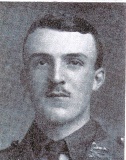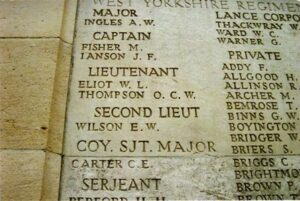The Township of Laugharne sits in a peaceful location in a valley at the outlet of the Rivers Tâf and Corran. The men of Laugharne who fell in both World Wars are commemorated on two separate Memorials in St. Martins Church and also on a relatively new memorial sited outside the newly rebuilt Memorial Hall, in Clifton Street, which contain the same names. For some reason these Memorials omit several local men, who I have taken the liberty to add on these pages. Due to the large numbers of photographs involved I have had to split the Laugharne WW1 and WW2 memorials onto two separate pages. This page commemorates those men of Laugharne who fell during World War One.
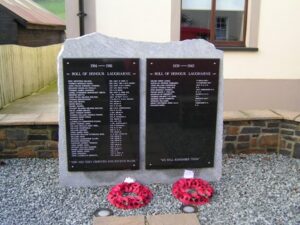
The Great War, 1914-1918
Arthur Laugharne Allen, Private, 291399, Welsh Regiment. Arthur was born in 1897 at Seaforth, Lancashire, the son of William Arthur and Ellen Allen. He was educated at the Merchant Taylor’s School at Liverpool, before the family moved to Gosport House, Laugharne, adding Laugharne as their middle name. Arthur enlisted into the Pembroke Yeomanry, and was posted to the 7th Welsh, before joining the 15th Battalion, Welsh Regiment, which was in France attached to 114 Brigade, 38th (Welsh) Division. The battalion was known as the Carmarthen Pals, and had been in France since December 1915. The Division had famously captured Mametz Wood during the Battle of the Somme in July 1916, and the Pilckem Ridge during the battle of Passchendaele, on 31 July 1917. Arthur probably joined the battalion after they had moved from Ypres to positions at Armentieres. During March 1918, the 15th Welsh was in reserve at The Laundry, Erquinghem. On 6 March they relieved the 13th Welsh in support trenches at Houplines, and over the coming days came under heavy fire from German gas shells. Arthur was killed when his position was shelled on 22 March 1918. He was just 20 years old, and is buried in Cite Bonjean Military Cemetery, Armentieres, France. Arthur’s Brother Cyril served as a Private in the Lancashire Hussars, and won the Military Medal for Bravery in the Field in November 1917 whilst attached to the Kings Liverpool Regiment.
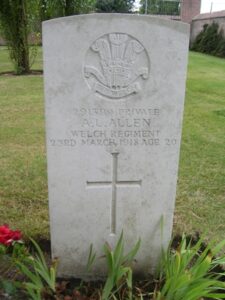
Geoffrey Fleetwood Andrews, Second Lieutenant, Royal Garrison Artillery. Geoffrey was born in 13, Bellots Road, Bath on 24 November 1898, the son of Albert and Mary Andrews. The family used to spend every summer in Laugharne, staying with Albert’s sister, Mrs Robert Bowen, in Duncan Street. Geoffrey enlisted into the RGA on 26 July 1917, and was commissioned as a Second Lieutenant in the Royal Garrison Artillery on 23 December 1917, being posted to 499 Siege Battery. The Battery had a very short life span; they went out to Western Front on 23 January 1918, equipped with 6 inch guns, and joined the 5th Army on 4 February 1918, after moving to the Somme sector. On 16 September 1918, Geoffrey was wounded during the British advance on the Somme. He died that same day at the 5th Casualty Clearing Station, at Proyart. Geoffrey was buried at Heath Cemetery, Harbonnières, France. Geoffrey is not commemorated at Laugharne.
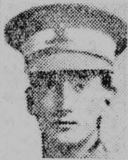
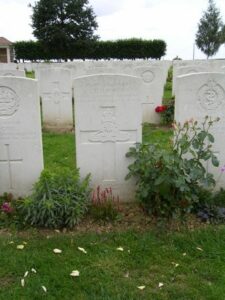
Arthur Edward Bathurst Beresford, Sergeant, 467, Australian Infantry. Arthur was the Son of Joseph Arthur Hamilton and Katherine Gertrude Beresford. His father Joseph had been born at Laugharne in 1862, and had lived at Devonport, before emigrating to Australia, where he joined the Royal Australian Navy in 1897, rising to the rank of Commander, and taking command of the Australian East African fleet at the outbreak of the Great War. Arthur was born at Devonport, and emigrated with his parents to Australia, with his wife Ellen M. Beresford. He enlisted at Melbourne at the outbreak of war into the 9th Battalion, Australian Imperial Force. Arthur fought at Gallipoli with the 9th Battalion, before being wounded, and evacuated to England for treatment. He was then posted to the 69th Battalion, and promoted Temporary Company Sergeant Major, before rejoining the 9th Battalion in France in February 1918, after a long recovery. Upon arriving in France Arthur was posted to the 26th Battalion as Sergeant, joining the battalion on the Somme. On 26 June, while in dugouts at Frechencourt, Arthur got into an argument with a Lance Corporal, and several hours later a hand grenade exploded in his dugout, severely wounding him. Arthur died at 61 Casualty Clearing Station on 29 June 1918. The perpetrator of the crime was duly court-martialled and suffered four years imprisonment. Arthur was 27 years old when he was killed, and he is buried at Vignacourt British Cemetery, France. Arthur is not commemorated at Laugharne.
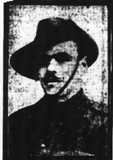
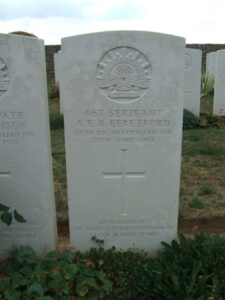
David Bevan, Private, 40116, Welsh Regiment. David was born around 1881, the son of Wilkin and Jane Bevan of Laugharne, and by 1901 was boarding with Rich Smith, a collier, at Ystradfodwg in the Rhondda, and worked as a Coal Hewer. Also lodging with him was his 23-year-old brother Richard Bevan. David enlisted into the army, and joined the 19th Battalion, Welsh Regiment. The battalion was formed as the Glamorgan Pioneers at Colwyn Bay during February 1915, as Pioneer Battalion to the 43rd (later renumbered the 38th) Welsh Division, and moved to France in December 1915. After a period of trench initiation in the Fleurbaix sector, some men of the 19th Welsh were attached to 255 Tunnelling Company, Royal Engineers. By May 1916 David was at Laventie, where 255th Tunnelling Company was at work digging mines beneath the German lines. The Battalion War Diary for the 19th Welsh during May 1916 is very sketchy, but during the first week of May, several men were wounded due to German sniper and grenade fire. David was wounded during this period, and died at the 33rd Casualty Clearing Station on 4 May 1916, aged 36.
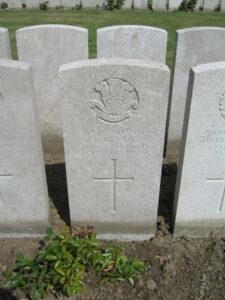
Henry Lewis Bevan, Private, 5444, Pembroke Yeomanry. Henry was born at Newbridge Road, Laugharne, the son of William and Sarah Bevan. He married a young widow with four children, Kate Wright, at Tenby Presbyterian Chapel on 11 June 1900, and the couple had another four children, Albert, William, Mollie and Sally, at their home at Frog Street, Tenby. He had served with the Pembroke Yeomanry for four years prior to the Great War, and re-attested on 3 December 1915 at Tenby, aged 40 years, into the 2/1st Pembroke Yeomanry. The battalion was formed as a Second-Line regiment in September 1914, moving to Carmarthen in early 1915, under orders of 2/1st South Wales Mounted Brigade. The Brigade moved during the year to Llandeilo, Dorchester and by September was at Yoxford, where it came under orders of the 1st Mounted Division. In July 1916 the battalion converted to a cyclist unit under orders of 2nd Cyclist Brigade in 1st Cyclist Division, and during November 1916 merged with the 2/1st Glamorgan Yeomanry to form the 2nd (Pembroke & Glamorgan) Yeomanry Cyclist Regiment, under 1st Cyclist Brigade. Henry remained on Home Service with the battalion throughout his time at war, due to his age. He became ill during the winter of 1916, and was discharged from the army on 5 January 1917, due to becoming ill with bronchitis. Henry died at home on 27 August 1918, aged 45, and is buried at Tenby (St. Mary) Church Cemetery. Henry is not commemorated at Laugharne, but on the Tenby War Memorial.
William John Lewis Bevan, Private, 12897, Welsh Regiment. William was son of William and Annie Bevan of Swansea, and the grandson of William Bevan of Island House, Laugharne. He enlisted in Swansea in 1914, alongside his brother Archibald Bevan, into the 9th Battalion, Welsh Regiment. The 9th Welsh was a service battalion, formed at Cardiff during September 1914, attached to 58 Brigade, 19th (Western) Division, and moved to France in July 1915. After a short period of trench initiation, the Division moved to the sector north of Loos, near Richebourg, and took part in the opening assault of the Battle of Loos on 25 September 1915. The battle was a disaster fro the British, and the position at Loos stagnated over the winter of 1915-16. It was during this period that William took ill, and was evacuated to the Base Hospital at St. Omer for treatment. He died of meningitis on 2 December 1915, aged 30, and is buried at Longuenesse Cemetery, St. Omer, France.
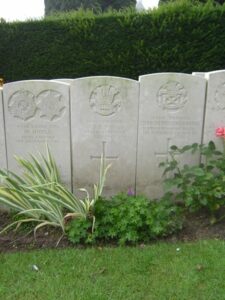
John Ritso Nelson Bolton, Lieutenant, Royal Field Artillery. John was one of two brothers from the same family who gave their lives in the Great War. He was the son of Lieutenant Colonel Arthur Heely Bolton and Mary Bolton of Elm House, Laugharne. During the 1901 census of England and Wales, John and his brother Stewart lived in Fullerton House, next to the Browns Hotel in Laugharne, with their aunt Elizabeth Leach, their sister Mary and two servants. John was educated at Bedford Grammar School, where he was elected Head Boy. In 1912, he won a place at the Royal Military Academy at Woolwich, and in August 1914 was gazetted as a Lieutenant in the Royal Field Artillery, serving in the 104th Battery, 22nd Brigade, which was attached to the 7th Division of the British Expeditionary Force. By the end of May 1915, John Bolton had proved his worth in the field of battle, after taking part in the Battle of Neuve Chapelle, and the Battles of Aubers Ridge, and Festubert, and was mentioned in Despatches for his bravery. By 25 September 1915, John was at Vermelles, where the 22nd Brigade, RFA took part in the opening barrage of the Battle of Loos. The battalion’s war diary for this day states that John was severely wounded at 1.30 p.m. by German counter-battery fire. John died two days later, on 27 September 1915. He was 22 years old, and is buried at the picturesque Foquieres Churchyard Extension, France. He was recommended for the Distinguished Service Order the same day, but the award could not be granted, due to it not being awarded posthumously.
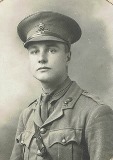
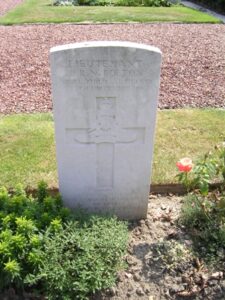
Stewart Bladen Nelson Bolton, Midshipman, Royal Navy. Stewart was the youngest son of Lieutenant Colonel Arthur Heely and Mary Bolton of Laugharne. He enlisted into the Royal Navy in May 1910, and served in a training establishment until August 1914, until being confirmed as a Midshipman on 2 August 1914. He joined the crew of the Battle Cruiser HMS Indefatigable on 14 May 1916. Indefatigable was commissioned in February 1911, and at the outbreak of the Great War in 1914 took part in the pursuit of the German Warships Goeben and Breslau, and also bombarded Cape Helles during the fighting at Gallipoli. After a refit at Malta she joined the Grand Fleet and just after Stewart joined the crew at Edinburgh, Indefatigable set sail from Leith, as part of the Grand Fleet, and moved into the North Sea in an attempt to intercept the German High Seas Fleet, which had been reported as leaving port. On 31 May 1916, Indefatigable took part in the famous Battle of Jutland. Sadly she became the first casualty of the battle, being struck by 11-inch shellfire from the SMS Van der Tann. Official reports state that she was hit by two shells in the X magazine, causing her to stagger out of formation, sinking by the stern. This was followed by another hit on the foredeck, causing a much larger explosion, which sank her. Of her company of 1,012, only two were picked up by the German navy, the ferocity of the explosions causing the loss of the remainder of the men. Unfortunately Stewart, after just 17 days service aboard Indefatigable, was killed in the explosion. He was just 18 years old, and is commemorated on the Plymouth Naval Memorial, Devon.
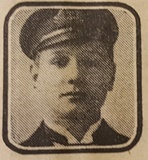
Trevor Bonham, Lance Sergeant, 2459, Welsh Regiment. Trevor was the son of Benjamin and Margaret Bonham. His father had been born in Laugharne in 1862 to an old Laugharne family of before moving to Swansea and by 1911 were living at Graig, Trebanos. Trevor was an army regular who had enlisted at Portsmouth into the Welsh Regiment prior to the war. He landed in France on 2 February 1915 and was posted to the 2nd Battalion, Welsh Regiment, which was in Flanders attached to 3 Brigade, 1st Division. The battalion had suffered terrible casualties since landing in France in August 1914, taking part in the retreat from Mons and the Battles of the Marne and the Aisne, before moving to Ypres, and was almost decimated at Gheluveld. By May 1915 the British had decided on an offensive at Aubers Ridge in conjunction with a French assault on Vimy Ridge, to the south, and on 9 May 1915 the Battle of Aubers Ridge began. Trevor was killed in action during the assault, when the 2nd Welsh were decimated by machine-gun fire as soon as they arose from their trenches. The 21-year-old has no known grave and is commemorated on panel 23 of the Le Touret Memorial, Richebourg-L’Avoué, France. Trevor is not commemorated locally.
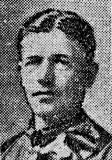
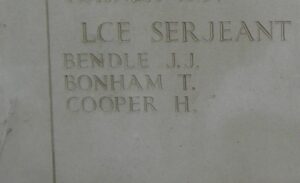
Isaac James Brace, Private, 24421, Royal Welsh Fusiliers. Isaac was born around 1898 in Aberdare, the son of James Brace and Elizabeth Anne Brace (nee Brown), of Laugharne. James was a Collier, and had moved with his young family to 2, Bell Vue, Aberdare. Isaac was well known in Laugharne, and often visited family there. Prior to the war, Isaac worked as a miner, and was an early recruit into the army, joining the Royal Artillery before being transferred to the 1st Battalion, Royal Welsh Fusiliers. On 1 October 1915 the battalion was attached to 22 Brigade, 7th Division, and were sent into the line at Cambrin, where the campaign at Loos had foundered. The Battalion did a tour of duty in the Cuinchy sector until 23 November 1915, passing through Bethune to Gonnehem, and on 5 December entrained at Lillers for Saleux. They then made an 18-mile march to Montagne, where they remained training until the end of January, when they moved up into the line at the Somme, east of Méaulte, on the Somme. By 22 February 1916, the Battalion was in the line at Morlancourt, improving the defences. On 1 July 1916, the 1st RWF took part in the opening of the Battle of the Somme, at the Battle of Albert. The 7th Division took part in the successful capture of Mametz Village, but during the fighting Isaac was badly wounded, and evacuated to the 36th casualty clearing station at Heilly. His wounds proved to be fatal, and Isaac died, aged 18, on 9 July 1916. He is buried at Heilly Station Cemetery, Mericourt-L’Abbe, France.
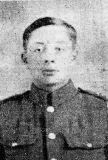
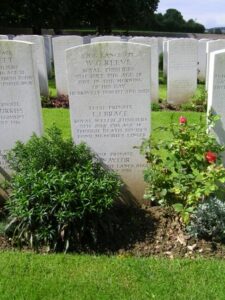
Thomas Hall Brigstocke, Petty Officer, 146229, Royal Navy. Thomas was the son of Sarah Brigstocke, of Gosport Street, Laugharne. Thomas had enlisted into the Royal Navy on 14 July 1888, and lived with his wife Bessie at 9, Greatlands Crescent, North Prospect, Swilly, Devonport. He had a long and interesting career, serving aboard many ships and working his way up slowly through the ranks. Thomas served all over the Empire; during The China War, India and South Africa, seeing much action. His papers show him to be a good seaman, and he was pensioned off on 1 July 1910. Upon the outbreak of the Great War, reservists were recalled for active service, and Thomas joined the crew of HMS Goliath, a Canopus Class Battleship, which was part of the 3rd Fleet (Pembroke Reserve). Her complement was drawn up from the naval reserve on 2 August 1914. Goliath was despatched in September 1914 to the East Indies for escort duties, operating against the German light cruiser Konigsberg in November. In April 1915 she was transferred to the Dardanelles to support the ill-fated Gallipoli landings around Cape Helles. She was damaged during the landings of 25 April and again on 2 May, and was sunk by three torpedoes fired by the Turkish torpedo boat Muavanet on 13 May 1915, with the loss of 570 of her crew, including Thomas. Being in the engine room, he had no chance of escape, even if he had survived the initial explosions from the torpedo strikes. Thomas was 48 years old when he died that day, and he is commemorated on the Plymouth War Memorial in Devon. He left behind his wife and eight children, the youngest of whom he never saw.
William Constable, Private, 12134, Welsh Regiment. William was the son of Philip and Jane Constable, of Horsepool Road, Laugharne. The family lived with Jane’s mother, Bridget Jones, along with Williams other brothers and sisters, Gwendoline, John and Neville. He went to London to work in a Drapers prior to the war and enlisted at Finsbury, in Middlesex, into the Royal Welsh Fusiliers. He was subsequently posted to the 19th Battalion, Welsh Regiment, which was the Pioneer Battalion to the 38th (Welsh) Division, and landed in France on 5 December 1915. After trench initiation at Fleurbaix, the 38th Division moved to the Cuinchy Sector, where the 19th Welsh became attached to 255 Tunnelling Company, Royal Engineers. In June 1916 the Division moved to the Somme, where it took part in the capture of Mametz Wood between 7 to 11 July 1916. After suffering heavy casualties at Mametz, the Division was posted to the sector north of Ypres, at Boesinghe. On 28 January 1917, William was in billets with his battalion behind the front lines at Trois Tours. The Battalion had been training and brought up to strength for the Summer Offensives, and were enjoying some relaxation in the Belgian towns around Poperinghe. Sometime that day, William was killed alongside several of his comrades in their billets by shellfire from German long range guns. William was 20 years old, and is buried at Ferme-Olivier Cemetery, Belgium.
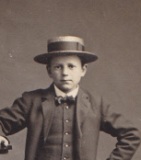
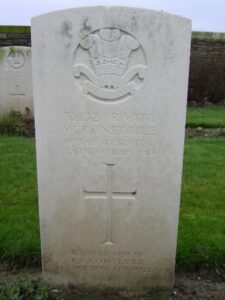
Henry John Hugh Cook, Private, 9093, Leicestershire Regiment. Henry was the Son of Henry and Elizabeth Frances Cook (nee Hugh), of The Outfall Works, Roxley, West Ewell, Epsom, Surrey. The family had spent a lot of time in Laugharne, as Elizabeth was born there, the daughter of Sarah Hugh, of Market Street, and her cousin Mr G. M. Wilkins owned the Newsagents shop. The family visited every summer, and were well known in Laugharne. Henry served at the outbreak of war with the 1st Battalion, Leicestershire Regiment, and landed in France on 8 September 1914, attached to 71 Brigade, 6th Division. The Division had arrived in time to reinforce the hard-pressed BEF on the Aisne, before the whole army was moved north into Flanders. Here they took part in the Action of Hooge during June 1915, and in 1916 moved to the Somme, where the Division fought at the Battle of Flers-Courcelette. Henry was killed during his battalions attack on Straight Trench on 15 September 1916. He was 23 years old. Henry has no known grave, and is commemorated on the Thiepval Memorial, France. His younger brother, Richard, had been killed two months previously. Neither brother is commemorated at Laugharne.
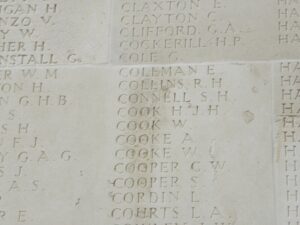
Kenrick Watkyn Brinley Richard Cook, Private, 16826, Machine Gun Corps. Richard, as he was known, was born in 1898 in Ewell, Surrey, the son of Henry and Elizabeth Frances Cook (nee Hugh), of The Outfall Works, Roxley, West Ewell, Epsom, Surrey. The family had spent a lot of time in Laugharne, as Elizabeth was born there, the daughter of Sarah Hugh, of Market Street, and her cousin Mr G. M. Wilkins owned the Newsagents shop. The family visited every summer, and were well known in Laugharne. Richard originally enlisted into the East Surrey Regiment, taking the service number 10970. He was trained as a company Machine Gunner, and was therefore brought into the newly formed Machine Gun Corps when they were formed in October 1915, with his service number changing to 16826. The 14th Machine Gun Company, of which Richard was part, formed part of 14 Brigade, 32nd Division, part of the Fifth New Army. The Division took part in the opening of the Battle of the Somme on 1 July 1916, known as The Battle of Albert. Just two days into the battle, while fighting at the Leipzig Redoubt, near Thiepval, Richard was killed in action. He was just 18 years old, and his body was lost in the carnage of the Somme battlefield, and so he is commemorated on the Thiepval Memorial to the Missing, France. His elder brother Henry was killed on the Somme three months later. Neither brother is commemorated at Laugharne.
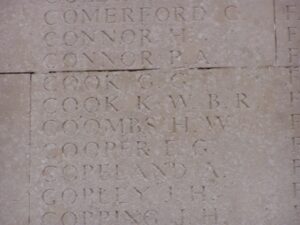
Arthur William Cooper, Private, 26005, King’s Shropshire Light Infantry. Arthur was born around 1898, the son of Arthur and Sarah Cooper, of Wheel Barrow Lodge, Easton Grey, Chippenham. Arthur’s father had moved the family to Laugharne before the war, and worked as the Head Gardener at Broadway Mansion, for Herbert Eccles. Arthur enlisted into the Hereford Regiment, then transferred into the 6th Battalion, King’s Shropshire Light Infantry. The 6th KSLI was formed in September 1914 as part of 60 Brigade, 20th (Light) Division, and landed at Boulogne on 22 July 1915. Arthur joined the battalion as a Signaller sometime in 1917. In 1917 the Division fought at the Battles of Langemark, The Menin Road, Polygon Wood, and at Cambrai. It was one of the divisions hit by the German offensive on the Somme on 21 March 1918, and during the summer of 1918 they were withdrawn to South West of Amiens, where they received several new drafts of men. The 20th Division took over the Mericourt Sector, near Arras, on 14 August 1918. The 6th KSLI replaced the 1st Notts and Derby Regiment in the line until 24 August, before being moved to the Acheville Sector. On 31 August the 6th KSLI were back in the line at Mericourt, just in time to see the Germans opposite them withdraw on the next day. September saw the British push the German Army back to the Hindenburg Line, and from 26 September 1918 the Allies launched four converging offensives against the Germans, which ultimately broke the Hindenburg Line defences and pushed the Germans to surrender. The 6th KSLI sent out a raiding party on 1 October, and came across a deserted German front line trench. The 20th Division extended its line the next day, and on 3 October sent out patrols to investigate how far the Germans had retreated. Another patrol of the 6th KSLI went out on 3 October 1918, and Arthur, as a Signaller went out with them. The patrol came under heavy fire and was forced to withdraw, but in the process, Arthur was killed. Arthur was 21 years old, and is buried at Cabaret Rouge British Cemetery, Souchez, France.
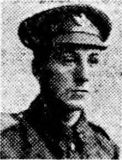
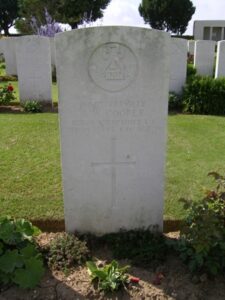
Robert Craig David, Private, 2161, Australian Infantry. Robert was one of four sons of Robert and Agnes David of Maroon, Queensland, Australia, who had had emigrated to Australia from Laugharne during the 1880’s, and all four enlisted and served in the Australian Imperial Forces in the Great War. Robert worked as a Stockman and was married to Edith Matilda David, but she sadly died soon after Robert enlisted into the 49th Battalion, AIF at Brisbane, on 24 February 1916. After training Robert embarked on the SS Arundel with the 4th Reinforcements, arriving in Plymouth on 13 October 1916. On 12 December Robert embarked from Folkestone, arriving at Étaples on 13 December 1916, and on 20 December was taken on strength in the field with the 49th Battalion. The Battalion formed part of 13 Infantry Brigade (Queensland), Australian Imperial Force, and had just taken part in heavy fighting on the Somme. Remaining on the Somme, the Australians took a major part in the winter operations in the Ancre Valley at the end of 1916, fighting alongside the British II Corps throughout the terrible winter months. On 5 February 1917, whilst in action near Bernafay Wood, Robert was mortally wounded. He was brought to the 12th Australian Dressing Station where he died of his wounds that same day, aged 32. Robert was buried in Bernafay Wood British Cemetery, but his grave was later lost owing to further fighting and shellfire on the site, and so Robert is remembered by a ‘Special Memorial’ inside the entrance, on which an inscription states ‘Known to Be Buried in This Cemetery’. Robert is not commemorated in Laugharne.
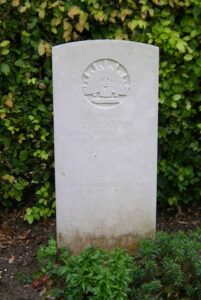
Thomas Jackson David, Lance Corporal, 6486, Australian Infantry. Thomas was a younger brother of Robert Craig David. He was born in Fassifern Station, Boonah, Queensland in 1885 and was educated at Engelburg State School, Boonah. At the outbreak of war, Thomas worked as a Stockman in Boonah, and was married to Margaret Kerr Sanderman. Thomas enlisted into the 15th Battalion, Australian Imperial Force, on 2 May 1916. The Battalion formed part of the 4th Brigade, commanded by the famous Colonel John Monash, and had taken part in fighting in Egypt and Gallipoli, before being sent to France in June 1916, forming part of the 4th Australian Division. Thomas sailed from Australia aboard HMAT Boonah, on 21 October 1916, as part of the 21st Reinforcements for the Battalion, and joined his Battalion on the Western Front. The winter of 1916 saw the 1st Anzac Corps carrying out operations around Gueudecourt on the Somme. It turned out to be a terrible winter for the Australians. The conditions were alien to the men from Down Under, and they suffered badly over the winter months. In January 1917, the Germans retired to the Hindenburg Line. By the end of March 1917, the Australians held a position around Bapaume, facing the Hindenburg Line and were putting pressure on the Germans, gaining ground toward Bullecourt and Hermies. Boursies and Demicourt were captured by the 4th Division during the first week of April, and then the 15th Battalion were plunged into the heart of an attack on Bullecourt. The 4th Division attacked two sectors of the German front between Bullecourt and Queant, with the 16th and 14th Battalions taking on the Hindenburg Line and the 15th and 13th tasked with passing through them to attack and capture Riencourt. Sometime during this attack, Private Thomas Jackson David disappeared and was reported as Missing in Action. After months of investigations and questioning of survivors of the attack, the AIF headquarters listed Thomas as having been killed in action on 11 April 1917. His body was never recovered, and so Thomas is remembered on the Villers-Brettoneux Memorial, France. Thomas is not commemorated at Laugharne.
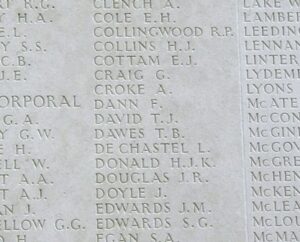
Thomas Morgan David, Lieutenant-Commander, Royal Navy. Thomas was born on 24 October 1875, the son of Thomas and Caroline David of South Hills, Laugharne, and a cousin to Lionel Mordaunt Smith. He was the husband of Eleanor David of 7, Wentworth Villas, Plymouth. Thomas had a long career in the Royal Navy, his service papers show that in 1897 he was training as a ships engineer, and passed ‘very creditably’. On 1 June 1899 he was serving on the HMS Compendium, and on 6 July 1902 was transferred to the Hannibal. His papers show him to be a very good engineer, taking an active role in ships life. Thomas then served on three ships before being posted to the Argonaut and then the Rattlesnake. His service record is full of praise for both his quality of work and his attitude. He was becoming a very highly regarded officer. On 13 February 1913, Thomas was posted to the Edgar class destroyer, HMS Hawke as Engineering Officer. On 15 October 1914, the Hawke was part of the 10th Cruiser squadron and was stationed off the North-East Coast. The Hawke was in convoy, steaming second in line behind the HMS Endymion and at 9.30 am had stopped to send a boat to the Endymion to collect mail. At 10.30 am the Hawke began steaming again, when she was hit by a torpedo abreast the foremost funnel, which had been fired by the German submarine U-9. She listed immediately and sank in a few minutes. There was only time to launch two lifeboats, with 21 men aboard, and 49 other men were picked up by a Norwegian steamship. The total loss of life in the disaster was nearly 524 officers and men including her Captain Williams. Only 70 men survived. Thomas, an officer with a great future ahead of him, was lost in the sinking of the Hawke. He is remembered on the Chatham Naval Memorial, Kent.
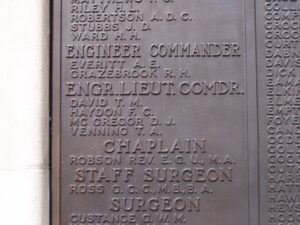
Daniel Davies, Private, 13369, Royal Welsh Fusiliers. Daniel was the son of Thomas and Mary Davies of the Grist, Laugharne. He had worked at Llanelli for several years prior to the war, and lived with his wife Malvina and their six children at 3, Pleasant View, Llanelli. Daniel enlisted at Llanelli into the 8th (Service) Battalion, Royal Welsh Fusiliers, which was attached to 40 Brigade, 13th (Western) Division. In July 1915 the Division landed at Mudros, then moved to the Gallipoli peninsula. Daniel landed on Gallipoli on 15 October 1915, as part of a batch of reinforcements. In January 1916 the 8th RWF were sent to Egypt, before heading through Suez on 14 February 1916, arriving at Basra on 28 February 1916. The 8th RWF was then involved in the bitter campaign against the Turkish army in Mesopotamia. The Battalion fought on throughout April 1916, pushing the Turks back through Falahiyeh, Sannaiyat, Beit Aieesa and Abu Roman Mounds. They were hit by savage Turkish counter-attacks, but held on, before being replaced in the front line on 28 April and moving to a rest camp. The Battalion were then entrenched in Beit Aieesa. At some time during this period, Daniel was shot in the back by a German sniper, and was sent to a Hospital in India. There he was operated on, having the bullet successfully removed, but succumbed to his wounds on 10 May 1916. Daniel is commemorated on the Kirkee Memorial, Poona, India.
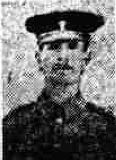
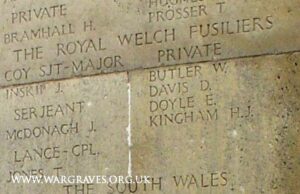
Thomas Davies, Corporal, 16317, Welsh Regiment. Thomas was born at Brynonen, near Bwlchnewydd Chapel, Laugharne in 1886, the son of John and Margaret Davies. The family moved to St. Clears when Thomas was young, and resided at Penpitch, with John working as a Platelayer with the GWR. The family later moved again, to 38, Henry Street, Bargoed. Thomas enlisted there soon after the outbreak of war into the 10th (Service) Battalion, Welsh Regiment. The Battalion had formed in 1914 and trained at Rhyl, then moved to Winchester, where it became part of 114 Brigade, 38th (Welsh) Division. Thomas landed with the battalion at Le Havre on 2 December 1915, and the Division moved to the Armentieres sector, where they were initiated into trench warfare. In June 1916 the Division marched south to the Somme, where on 7 July 1916 it launched its assault on the fortified Mametz Wood. The initial attack was repulsed at a heavy cost of lives due to well positioned German machine guns, and after a change in Commander renewed its assault on 10 July. The initial assault was renewed by 114 Brigade on the right, with two battalions of 113 Brigade on the left. Thomas was with the 10th Welsh in reserve, on the ground overlooking the wood. Later in the morning the 10th Welsh were sent into the wood to reinforce the Brigade. Thomas was wounded in the head at Mametz, and sent back to the UK via Hospital Ship. He died of his wounds at the 1st Welsh General Hospital, Liverpool on 23 July 1916. His body was brought back to Bargoed for burial, but he is commemorated on the Brookwood Memorial, Surrey, so his place of burial was not reported to the authorities. Following a lot of work, I have finally discovered that he is buried in Bedwellty (St. Sannan) Churchyard. I forwarded evidence to the CWGC in order for them to amend their records and this enabled Thomas to have a CWGC headstone, after 101 years without one! Thomas is not commemorated anywhere locally.
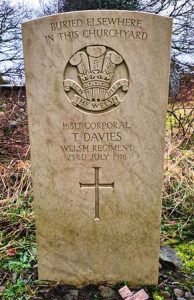
John Henry Dodd, Private, 22050, Royal Engineers. John was born on 15 April 1893 at Penlan-Coed, Aberarth, Cardiganshire. His father Charles was a publican from Shropshire, and his mother was Anne Dodd. By 1901 the family lived at the Ram Inn, Coedmore, Carmarthen, before John moved to Dan-y-Coed, Llanddowror. John joined the army on 29 August 1917 and was placed into the 68th Battalion Training Reserve, based at Ripon in Yorkshire. In December 1917 John was transferred to 635th Home Service Company, Labour Corps. The 635th Home Service Company was stationed at Larkhill from September 1917 to April 1919, and then moved to Durrington until disbanded in June 1919. They were employed as cooks, clerks, orderlies, camp staff etc. John was seconded to the Royal Engineers and was sent to France on 15 January 1918, but by the end of March, had been sent home to Plymouth Hospital suffering from Shellshock. John received treatment at Devonport and Lyme Regis Hospitals before being recalled to the Labour Corps at Salisbury Plain on 20 August 1918. At the beginning of October 1918, John was taken seriously ill with Pneumonia and was sent to Bulford Manor Convalescent Home. He recovered and rejoined his unit, but soon fell ill again, and in February 1919 he was taken to Fargo Military Hospital, and then transferred to Plymouth Military Hospital where he died after an operation, aged just 26 on 1 July 1919. John is buried in the Efford Cemetery in Plymouth.
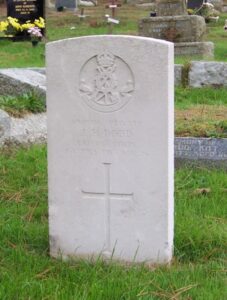
The Honorable Cecil Edwardes, Captain, Scottish Horse & Tank Corps. Cecil was born on 31 May 1876, the son of William Edwardes, 4th Baron Kensington and his wife Grace Elizabeth. The family had a residence at St. Bride’s Hill, Pembrokeshire, and Cecil lived here for long periods with his wife, Marie Louise Edwardes (nee Martin) of Canada, as well as spending time at another family residence at Llandawke Manor, Laugharne. Cecil had served with the Royal Navy, but by the time of the war had been commissioned into the Scottish Horse. During 1916 Cecil had transferred to the newly formed Tank Corps. He served with ‘H’ Battalion, which took part in the opening of the Battle of Cambrai on 20 November 1917. Six tanks from H Battalion took Fontaine, four miles from Cambrai, bursting through the Cantaing Line and getting into the village half an hour before infantry of the Seaforth Highlanders and Argyll and Sutherland Highlanders from the 51st Division followed up and occupied it. Cecil was killed when his tank was knocked out during the initial advance that day. He was 41 years old, and has no known grave, and so he is remembered on the Cambrai Memorial, Louverval. Cecil does not appear to be commemorated at Laugharne, unless there is a memorial in Llandawke Church?
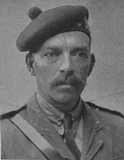
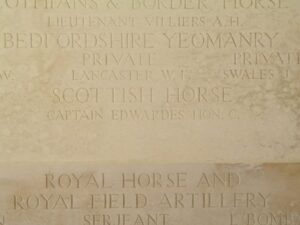
Austin Roland Edwards, Able Seaman, Z/3857, Royal Naval Volunteer Reserve. Austin was born on 7 March 1898, the son of Thomas and Jane Edwards, of Victoria Street. He worked as a postman prior to the war and enlisted into the Royal Naval Volunteer Reserve on 18 November 1916. Austin trained at HMS Victory VI before being posted to HMS President III. He remained on shore establishment throughout the war and was demobilised on 27 February 1919. Austin died at Milford Haven in June 1920 and was buried in St. Martin’s Churchyard on 12 July 1920. He is not a casualty of war so is not commemorated by the CWGC and is not named on the Laugharne War Memorial, but his death shows how young men continued to die in the aftermath of the war.
David James Edwards, Gunner, 190346, Royal Field Artillery. David was born in Aberystwyth in 1883, the son of Evan and Anna Marie Edwards of 48, Cambria Street, Aberystwyth. During 1908 David married Elizabeth Roberts, of Lower Gosport Street, Laugharne. In 1916, David was called up and became a Gunner in ‘A’ Battery, 296th Brigade, Royal Field Artillery, which was attached to the 59th (Second North Midland) Division. In April 1916, the Division moved to Ireland to help quell the Republican uprisings that were gathering momentum at the time, and took part in the fighting of the Easter uprising. In January 1917 the Division returned to England, before heading to France in February, moving to Ypres. David was part of the crew of a Gun Battery that took part in the shelling of the German Lines which marked the beginning of the Battle of the Menin Road, on 20 September 1917. After weeks of heavy fighting, the artillery was slowly moved forward, keeping pace with the slow advance of the infantry. David was wounded at the Battle of Polygon Wood, and was brought back to the Casualty Clearing Station at Dozinghem, where he died of his wounds on 29 September 1917, aged 33. David’s widow, Elizabeth Edwards stayed in Laugharne, residing in Gosport Street. David is not commemorated in Laugharne.
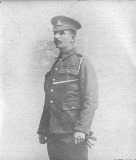
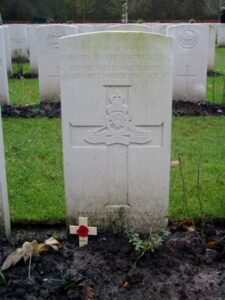
James Tudor Edwards, Second Lieutenant, King’s Liverpool Regiment. James was born in 1892, the son of Walter and Elizabeth Edwards, of 42, Dunraven Place, Bridgend. Walter was from Laugharne, but had moved to the valleys to work as a Draper, and eventually ran his own business at Bridgend. Walter died in 1906, so Elizabeth retired to Llynrhos, Newton, Porthcawl. James was educated at Cowbridge Grammar School and Jesus College, Oxford, and on the outbreak of war enlisted into the King’s Liverpool Regiment. He was commissioned into the 3rd Battalion, Liverpool Regiment on 18 November 1914. He married Grace Margaret Austin, of Westminster in Nottinghamshire while on leave early in 1915. On 7 June 1915 James landed in France, attached to the 4th Battalion, Liverpool Regiment. The battalion was originally attached to the Lahore Division, Indian Corps, and was in positions near Loos. James was killed in action here on 13 September 1915, aged 22. He is buried in Cabaret-Rouge British Cemetery, Souchez. Grace married Edward Bramall in 1924, and died in 1987. James’s probate was granted to his wife Grace, and to his cousin, James John, at Laugharne. James is not commemorated in Laugharne.
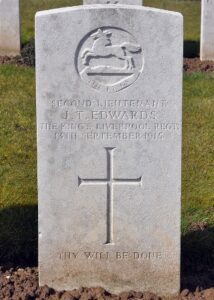
Richard Edwards, Private, 56935, Welsh Regiment. Richard was born around 1890 at Morfa Bach Cottage, Laugharne, the son of David Edwards, a railway platelayer, and Lizzie Edwards. Richard served in the Pembroke Yeomanry, with the rank of Private and the service number 5193, before transferring to the 13th (Service) Battalion, Welsh Regiment. The Battalion was raised in Cardiff as the 2nd Rhondda Battalion on 23 October 1914, and eventually became part of 114 Brigade, 38th (Welsh) at Rhyl. In December 1915 they landed at Havre, and after a short period of trench initiation, moved to the Somme, where the Division captured Mametz Wood. After suffering heavy casualties after Mametz, the Division moved to Ypres, which is where Richard joined his new battalion, during August 1916. He survived the Divisions successful capture of the Pilckem Ridge in August 1917, before the Division moved to Armentieres, then to positions near Albert on the Somme in March 1918. Richard was killed during an operation to straighten the Welsh lines on the Somme on 24 April 1918. He was 18 years old, and is buried in Contay British Cemetery, France.
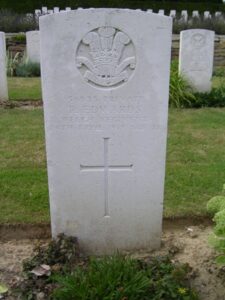
Llewellyn Humphreys Evans, Private, 25830, Lancashire Fusiliers. Llewellyn was born in Laugharne around 1893, the son of James and Eliza Evans, who were farmers living at Grassland Farm, near Brixton Farm in Laugharne. He had two older brothers, Richard James Evans and William James Evans. Llewellyn enlisted at Carmarthen, and was posted to the 15th (Service) Battalion, Lancashire Fusiliers, the Salford Pals. The battalion landed in France on 22 November 1915 attached to 96 Brigade, 32nd Division, and moved to the Somme Sector. Llewellyn was killed in action while in the front line near Munich Trench, at Beaumont Hamel, on 26 November 1916. He was 23 years old, and is buried at Mailly Wood Cemetery, France.
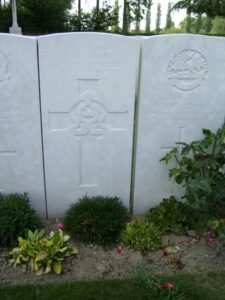
Thomas William Arnold Evans, Private, 18043, Welsh Regiment. Thomas was born around 1887 in Market Street in Laugharne, the son of George and Marianne Evans. Thomas was living in Loughor at the outbreak of war, with his wife Elizabeth Sarah Evans, who was also born in Laugharne. They had married on 12 April 1909 and had no children. His trade upon enlistment was butcher. Thomas volunteered at Swansea into the 14th Battalion, Welsh Regiment on 14 December 1914. The battalion was known as the Swansea Pals, and became part of 114 Brigade, 38th (Welsh) Division, landing at Le Havre in December 1915. Thomas fought through the bloody capture of Mametz Wood, and moved with the Division to Ypres in August 1916. According to the War Diary for the 14th Welsh, the Battalion were based at Brandhoek at the start of September 1916. The battalion moved to Camp E, then into reserve and were relieved by the 17th Royal Welsh Fusiliers at Machine Gun Farm and Canal Bank. The battalion was shelled during its relief, and several men were badly wounded, including Thomas. He died of his wounds on 17 September 1916 at No. 3 Canadian Casualty Clearing Station, and was buried in Lijssenthoek Military Cemetery, Belgium.
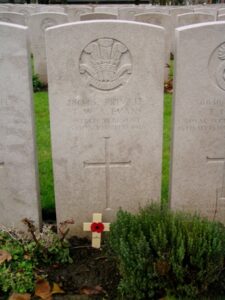
William Ivor Evans, Private, 3941, Welsh Regiment. William was the son of Maurice and Anne Evans. The family was originally from Windmill Farm, Laugharne, but had moved to 64, High Street, Tumble prior to 1911. William enlisted at Tumble into the 1/4th Battalion (Carmarthen), Welsh Regiment, which was the local territorial battalion, attached to 159 Brigade, 53rd (Welsh) Division. The division landed at Gallipoli on 8 August 1915, and was plunged head first into terrible fighting. William was killed on his second day on Gallipoli, on 10 August 1915, during the Battle of Sari Bair (Attack on Scimitar Hill). He was 24 years old, and is commemorated on the Helles Memorial, Gallipoli. William is not commemorated at Laugharne.
David Emrys George, Greaser, 912812, Mercantile Marine Reserve. Emrys was born in Laugharne in 1898, the Son of Frank and Martha George. The family had moved to Pantyderi Mill, Blaenffos prior to 1911. Emrys served in the Mercantile Marine, aboard the River Class destroyer H.M.S. Derwent. She was built by Hawthorn Leslie and launched in 1904. She was 200 feet long and her Yarrow boilers produced 7,000 H.P. and a top speed of 26 knots. She was fitted with sponsons, rather than turbines, and was originally armed with one twelve pounder but was upgraded to four such guns, and two torpedo tubes. Derwent served in home waters during the Great War and was sunk by a mine of Le Havre on 2 May 1917. Emrys was drowned with the sinking of the ship that day. He was just 18 years old, and is commemorated on the Plymouth Naval Memorial, Devon. Emrys is not commemorated at Laugharne, but on the new war memorial at Eglwyswrw.
John Llewellyn Griffith, Private, 51673, Gloucester Regiment. John was born around 1897 in a ‘Cottage by the Cliff’ in Laugharne, the son of William and Mary Griffith. His father was a gardener. John had four brothers; Hubert, Granville, Harold and Hector, and two sisters, Constance and Eira Griffith. There are no surviving records of John’s wartime service, but he served in the 4th Battalion, Gloucester Regiment, a Territorial Battalion, which was formed on 4 August 1914 at Bristol. The Battalion was sent to France in March 1915, as part of 144 Brigade, 48th Division, and in November 1917 moved to Italy. John died in the Military Hospital at Newcastle-on-Tyne of Meningitis on 29 February 1920, aged just 23, and was buried in St. Martins’ Churchyard in Laugharne, to the North of the Church in the old graveyard.
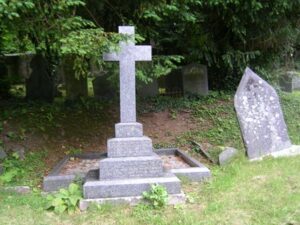
Gomer Hitchings, Private, 75318, Welsh Regiment. Gomer was the son of William and Mary Hitchings, of 65, Brynhyfryd Street, Blaenclydach, Rhondda. He enlisted at Porth into the army, and was posted to France in the summer of 1918 to join the 13th Battalion (2nd Rhondda), Welsh Regiment, which was attached to 114 Brigade, 38th (Welsh) Division. Gomer joined the battalion in time to take part in its crossing of the River Ancre on 21 August 1918, and fought with the battalion during the great advance that followed. Gomer was killed during the fighting around Gouzeaucourt on 8 October 1918, during fighting around Villers Farm. He was 23 years old, and is buried at Unicorn Cemetery, Vend’huile, France. William was from Laugharne, where the Hitchings were a well-known family, and Gomer regularly visited relatives in the Township. Gomer is not commemorated at Laugharne.
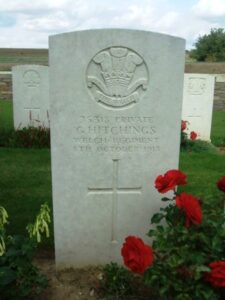
Joseph Hoare, Gunner, 1410699, Royal Garrison Artillery. Joseph was born in Market Street, Laugharne in 1899, the son of James and Francis Hoare. His father was a Policeman, and by 1911 the family had moved to Bonville House, Llansteffan. Joseph had enlisted in August 1914, at the grand age of 14 years old, and was posted to the Royal Garrison Artillery barracks at Plymouth as a Bugler. He later served in France and in East Africa during the war, returning home on leave in January 1919, before returning to Africa. He was later posted to Ireland during the height of the troubles, attached to the 19th Battery, 5th Brigade, Royal Garrison Artillery. Joseph died after being accidentally shot while on duty in Ireland on 10 June 1921, aged just 21. The Welshman newspaper reported that he had died of self-inflicted injuries, but another report in The Independent stated that he was actually trying to save a comrade who was trying to kill himself and the gun accidentally went off, killing him. Joseph is buried in Llansteffan Churchyard and the base of his CWGC headstone states that ‘He died to save a comrade’, so the Independent article was more likely correct.
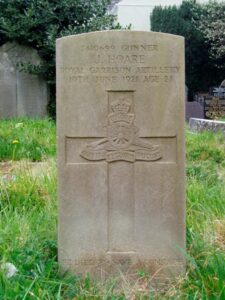
William John Howells, Captain, Welsh Regiment. William was born in White Lion Farm, Eglwys Cummin, in 1888. His Grandfather was Ben John of Brook, who William was living with before he enlisted. William was educated at Tremoilet School and Whitland Grammar Schools, before gaining a BA with Honours at Aberystwyth University. He then moved on to work in Lampeter University before the war broke out. William enlisted into the Welsh Regiment at the outbreak of hostilities, and was commissioned into the 8th Battalion, the Welsh regiment as a Lieutenant. The 8th Battalion formed at Cardiff during August 1914 as attached to 40 Brigade, 13th Western Division. The Division assembled at Salisbury Plain, and in June 1915 moved to the Mediterranean. On 4 July 1915 the Division landed on Cape Helles and relieved the 29th Division. From there, the Division took part in several actions, most notably The Battle of Sari Bair. The Battalion War Diary for the period from 8 August 1915 shows that they had moved up to positions around Chunuk Bair, in support of the Gloucester’s and the Wellington Battalion. The fighting was ferocious and the diary shows that on that one day, the 8th Welsh suffered 4 Officers and 4 Other ranks killed, 9 Officers and 154 Other Ranks wounded, and 4 Officers and 266 Other Ranks Missing in Action. One of the wounded officers was Captain William John Howells. William was evacuated from Gallipoli, but died of his wounds on 10 August 1915 aboard the Hospital Ship HMHS Valdivia. William was buried at sea, so he is commemorated on the Helles Memorial, Turkey. William is commemorated at Whitland, but not at Laugharne.
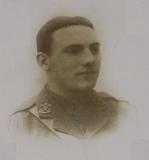
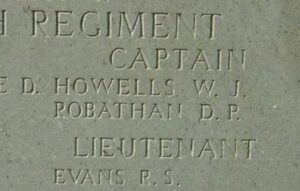
Augustus Edward Hugh, Private, 45307, Welsh Regiment. Augustus was the son of David James and Charlotte Hugh, of Bay View, Station Road, Kidwelly. His father David was from Laugharne, and Augustus was a regular guest with his family there. Augustus enlisted at Haverfordwest into the 8th Battalion, Welsh Regiment, who were attached to 40 Brigade, 13th (Western) Division. The Division concentrated at Blackdown in Hampshire, and on 13 June 1915 left Britain for Alexandria. By 4 July1915, the Division moved to Mudros, then landed at Gallipoli between 6 and 16 July 1915, relieving the 29th Division. They left and returned to Mudros at the end of the month, and the entire Division landed at ANZAC Cove from 3 August 1915, taking part in the Battles of Sari Bair, Russell’s Top, and Hill 60, ANZAC. Soon afterwards the Division was transferred from ANZAC to Suvla Bay, and it was evacuated from Suvla on the 19th December 1915, whereupon the infantry moved after a weeks rest to the Helles bridgehead, where they faced the last Turkish attacks at Helles. On 8 January 1916, the Division was evacuated from Helles, and by 31 January was concentrated at Port Said, where they held forward posts in the Suez Canal defences. On the 12th February 1916 the Division began to move to Mesopotamia, to strengthen the force being assembled for the relief of the besieged garrison at Kut al Amara. Augustus was killed in action during the advance into Mesopotamia on 14 January 1917. He was 36 years old and is buried at Amara War Cemetery, Egypt. Augustus is commemorated at Kidwelly and not at Laugharne.
Thomas James Jackson, Private, 18440, South Wales Borderers. Thomas was born in Gosport Street, Laugharne, in 1896, the son of David and Harriet Jackson. His father was a mason (builder). Thomas enlisted into the army in October 1914, and after training joined the 2nd Battalion, South Wales Borderers, which had just returned from China, where they aided the Japanese army to force the German garrison from Tsingtao. They embarked from Hong Kong on 4 December 1914 for Plymouth. Once back on British soil, they joined 87 Brigade, 29th Division at Rugby, and this is where Thomas Jackson joined his Battalion. On 17 March 1915 the battalion sailed from Avonmouth on the SS Canada for Alexandria, and on 25 April 1915 they landed at Gallipoli. Thomas was slightly wounded just after arriving at the Dardanelles, and wrote home to his parents to inform them. On 10 June 1915, an attempt was made to dislodge the Turks from a trench east of the Gully Ravine. Thomas was one of a party of men under Lieutenant Inglis who attempted to bomb their way into the Turkish lines. Unfortunately Thomas became one of six men killed out of the party that day. He was 19 years old and was buried at Twelve-Tree Copse Cemetery, Gallipoli.
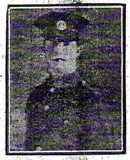
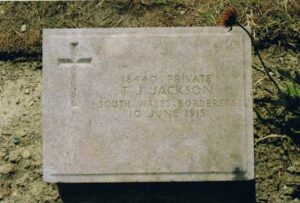
James Wright James, Captain, Hampshire Regiment. James was the son of James and Annie James (nee Fleming), of 4, Dynevor Terrace, Llandebie. His mother Annie was from Laugharne, and James often stayed with family in the Township. James resided at 81, College Road, Ammanford, and was Chairman of the Conservative and Unionist Association. James served with the 15th Battalion, Hampshire Regiment, attached to 122 Brigade, 41st Division. This Division was formed in September 1915, and moved to France by 6 May 1916, concentrating near Steenwerck, where they began familiarisation with trench warfare in the areas of Ploegsteert and the Douve valley, south of Ypres. They remained here until August 1916, when they moved to the Somme, and took part in the Battle of Flers-Courcelette. The Division remained in the line, pushing on to Courcelette over the next few days before coming out for a rest and re-fit. They then fought at the Battle of Le Transloy, and it was just after this that James was killed in action, on 7 October 1916. He has no known grave, and so is remembered on the Thiepval Memorial, France. James is not commemorated at Laugharne.
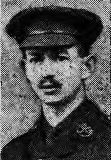
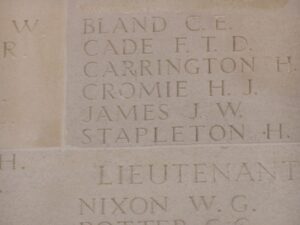
David Thomas John, Lance Corporal, 244, Australian Infantry. David was born on 2 July 1891, the eldest son of William and Eliza John, of Halfpenny Furze, Laugharne. David had a younger brother John James John, and a sister Mary Ann John who were both born in Glamorgan. Their youngest sister Sarah Jane John was born in Laugharne, in Halfpenny Furze. In 1913, David John married Lillian Evans of Laugharne, and they had a son, John William John. In 1913 David ran away from his family, and ended up in Bulli, New South Wales, where he found work as a Coalminer. On 18 August 1914, he enlisted at Randwick, NSW into the 4th Battalion, Australian Infantry, which was part of the 1st Australian Division. In October 1914 the battalion left Australia aboard the Troopship Euripides, and on 4 December disembarked at Cairo. After intensive training, the 1st Australian Division landed at Gallipoli on 25 April 1915, and took part in heavy fighting securing their beach-head at Anzac Cove. On 29 July 1915, David was temporarily transferred to duties with Brigade Engineers as a well sinker, but by 24 August 1915, David was suffering badly with fever, and was admitted to a Casualty Clearing Station, diagnosed with Pyrexia. David rejoined his Battalion on 2 January 1916, after it had evacuated from Gallipoli. On 29 March 1916, the Battalion boarded the troopship Transylvania and embarked from Alexandria to join the BEF in France, landing at Marseilles on 6 April 1916, and moving to positions in Northern France, at Fromelles. The Battle of the Somme began on 1 July 1916, and the 1st Australian Division had been moved to the Somme, where it captured the strongly defended Pozières Ridge. On 11 August 1916 David was promoted to Lance Corporal, and his Battalion were sent back to the front line, directly opposite Mouquet Farm. At around 14.00 on 18 August 1916, David was sent out in charge of a patrol, which had been detailed to locate the German front line at Mouquet Farm, when the patrol was surprised by a German patrol. David and Private Oliver Williams were killed in the ensuing firefight. David was buried between Pozières and Mouquet Farm, but his grave was lost during further fighting, and today he is remembered on the Villers-Brettoneux Memorial, France. He was 25 years old and had left a 3-year-old son behind, my paternal Grandfather.
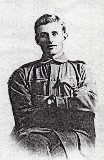
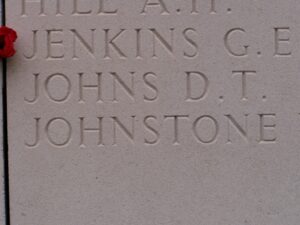
John James John, Private, 320374, Welsh Regiment. John was a younger brother of David Thomas John, and had been born on 21 May 1895 at Pontygwaith, Tyler’s Town, the youngest child of William and Eliza John. The family later returned to Laugharne, living at Halfpenny Furze. John worked at Llansteffan prior to enlisting into the Pembroke Yeomanry in 1915, and in 1916 moved to Egypt, where the Pembroke Yeomanry took part in actions against the Senussi Tribesmen. In 1917, the Pembroke and the Glamorgan Yeomanry merged and became the 24th Battalion (Pembroke & Glamorgan Yeomanry), Welsh Regiment, attached to 231 Brigade, 74th Division. After a successful campaign in Palestine, where the 74th Division took part in the capture of Jerusalem, in May 1918 the Division was sent to France, to make up the heavy losses suffered by the British during the German offensives of March and April. The 24th Welsh landed at Marseilles on 7 May 1918, and moved to Northern France. After helping to steady the line in Flanders, the Division moved to the Somme, to take part in the Battle of Épehy, which was a move towards the Hindenburg Line. John was killed in action during the 24th Welsh attack on Gillemont Farm on 21 September 1918. He is buried at Unicorn Cemetery, France, just fifteen miles from where his brother David fell.
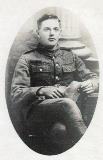
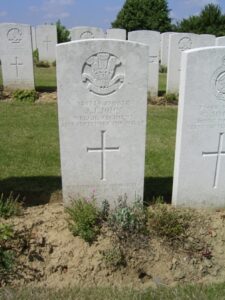
John James John, Private, 60742, Welsh Regiment. John was born around 1898 in Laugharne, the son of David and Letticia John, of 7, Gosport Street, Laugharne. He initially joined the Pembroke Yeomanry, then transferred to the 15th Battalion, Welsh Regiment, known as the Carmarthen Pals. John probably joined the battalion at Ypres in 1916, after it had been withdrawn, along with the rest of 114 Brigade, 38th (Welsh) Division, to positions at Boesinghe. John was wounded in the head during the battalions attack on the Pilckem Ridge on 31 August 1917. He was evacuated to the Casualty Clearing Station at Proven, where he died of his wounds that same day. John is buried at Mendinghem Military Cemetery, Belgium. His medal card shows that he had served with the 14th Welsh for a spell.
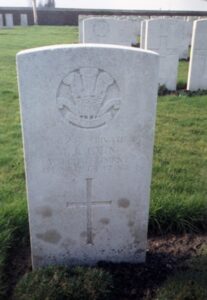
Moses David John, Sapper, 327094, Royal Engineers. Moses was the son of Rees and Annie John, of 10, Queen Street, Maesteg. His father Rees was from Laugharne, but had moved to Swansea while very young, due to his father John John having found work there as a haulier and moving his entire family from Laugharne. Moses worked as a coalminer prior to enlisting at Cardiff into the Royal Engineers, and was posted to France in 1916, joining the 182nd Tunnelling Company, Royal Engineers, which was working on the construction of deep mines below Messines Ridge. Once work was completed at Messines the Company moved to Armentières before being sent to construct deep dugouts and subways in Zouave Valley, in front of Vimy Ridge. By the time of the German Spring Offensive of 21 March 1918 the Company was in the southern British sector occupied by Fifth Army and was used as infantry in a desperate attempt to stop the German break-through. It also took an active part during the 100 Days Offensive from August 1918, being involved in the capture of the Bellicourt canal tunnel, Landrecies and Le Cateau. Moses was killed in action during the final offensive of the war, during the Battle of the Sambre, on 4 November 1918, aged 22. He is buried in Cross Roads Cemetery, Fontaine-Au-Bois, France. He is not commemorated at Laugharne.
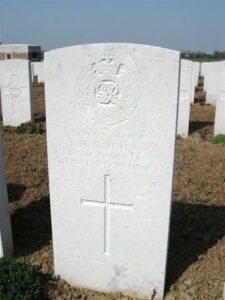
William John, Private, 320285, Welsh Regiment. William was the son of James and Sarah John of Spring Gardens Cottage, Laugharne. He originally enlisted into the Pembroke Yeomanry, and fought with them in Egypt before they merged with the Glamorgan Yeomanry to form the 24th Battalion, Welsh Regiment, on 2 February 1917 in Egypt. This new battalion formed part of 231 Brigade, 74th Division. The Division moved into Palestine in 1917, where they took part in the Second and Third Battles of Gaza, capturing the City of Jerusalem. William was killed in action on the Jerusalem Road, on 27 December 1917, while the battalion was holding Hill 1910 R13C, which they had captured the previous day. William was 22 years old, and was buried where he fell. His grave was lost, and today William is commemorated on the Jerusalem War Memorial, Israel. Serving alongside him at the time were two local men; Private David Saer of St. Clears, who was killed alongside William, and Corporal J. Raymond of Laugharne, who wrote home to his parents, telling them of the event, where he saw William shot through the eye. William’s family erected a headstone in St. Martin’s churchyard in Laugharne, which stands in the old graveyard.
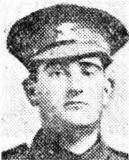
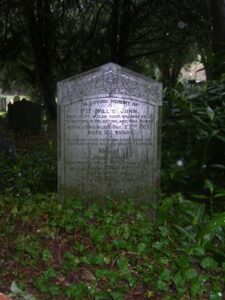
William John, Private, 55464, Royal Welsh Fusiliers. William was born at Tenby on 6 August 1883, the son of William John and Margaret John (nee Phillips), who had moved there from Laugharne. He married Martha Elizabeth Davies in 1908, and the couple raised four children, at 29, Victoria Street, Tenby. William enlisted at Tenby into the Pembroke Yeomanry, but later transferred into the 16th Battalion, Royal Welsh Fusiliers, part of 113 Brigade, 38th (Welsh Division). The Division embarked at Folkestone on 5 December 1915, disembarking at Boulogne the same day. During the winter and spring of 1916 the Battalion held the line in the Armentières sector, and at the end of May, 1916 moved South with the remainder of the 38th (Welsh) Division to the Somme area, in readiness for the First Battle of The Somme. The 38th Division was tasked with the taking of the infamous Mametz Wood, with the first attack going in on 7 July, when the division lost heavily in ‘Death Valley’ during the advance on the ‘Hammer Head’. The next attack went in on 10 July and by 12 July the wood was cleared. Due to the terrible casualties taken by the Division during the capture of Mametz Wood, they were removed from the front, and posted to Ypres to rebuild. William was sadly killed in action during that first winter at Ypres, on 15 January 1917, aged 33. He is buried at Essex Farm Cemetery, Belgium. William is commemorated at Tenby but not at Laugharne.

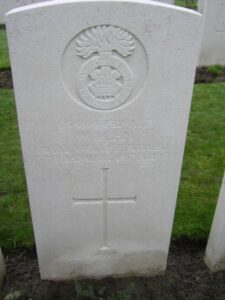
Joseph Johnson, Private, 29688, East Yorkshire Regiment. Joseph was born in London in 1889, the son of James Henry and Emma Johnson. Joseph moved to Llanddowror before the war, finding work as a Farmhand, and married Mary Phillips on 25 October 1913. He enlisted at Carmarthen on 11 March 1915, and joined the Army Service Corps as a Driver. In France, he was attached to No. 1 Section, 99th Company, 27th Reserve Park, before being posted to the 1st Battalion, East Yorkshire Regiment, who were part of 64 Brigade, 21st Division. From June to July 1916, the Battalion took part in the Battle of Albert, the opening of the Battle of the Somme. They moved to the Ypres Salient in 1917, before returning to the Somme in 1918. On 21 March 1918, the Germans launches a massive offensive on the Somme, and the 21st Division was caught up in terrible fighting. Joseph was killed in action on 31 March 1918 whilst his Battalion were fighting a fierce defensive battle against the superior numbers of the German Army. It shows how chaotic and awful the conditions were, as nothing at all had been heard of him by his family, until Christmas Day 1919. Joseph’s wife received a telegram from the War Office saying that he had been confirmed as killed. Joseph was 29 years old. His body, like so many others of that terrible time, was lost, and so Joseph is remembered on the Pozieres Memorial, France. Sadly, Joseph left two children; Oliver Henry Johnson had been born on 2 March 1915 and Joseph Randall Johnson born on 20 July 1917. Joseph’s bereaved widow Mary died on 10 February 1920 after a short illness, leaving the two boys orphaned.
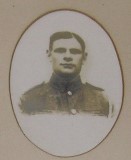
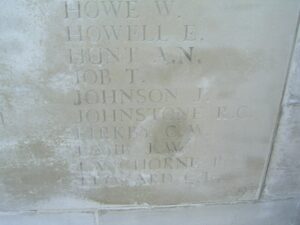
Frederick George Jones, Private, 6647, King’s Shropshire Light Infantry. Frederick was born at Pembroke Dock, the son of William and Aminda L. Jones. His father William was from Laugharne and Frederick had often visited his relatives in the Township prior to the war. Frederick enlisted into the 3rd Battalion, King’s Shropshire Light Infantry, which was a Reserve Battalion based at Pembroke Dock. He died at Pembroke Dock on 15 April 1915, aged 19, and is buried at Pembroke Dock Military Cemetery. The family later moved to 555, Oldham Road, Rochdale after the war. Frederick is not commemorated at Laugharne.
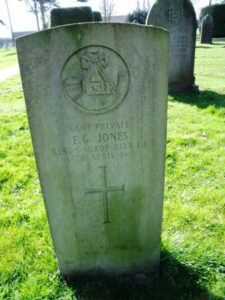
Sydney Jones, Private, 227535, Monmouthshire Regiment. Sydney was the son of Thomas and Francis Jones, of 25, Upper William Street, Llanelli. Sydney’s mother was from Laugharne, and the young Sydney often returned to Laugharne to visit family. He enlisted at Llanelli on 15 February 1916 into the Monmouthshire Regiment, and landed in France on 16 June 1917. Sydney was then posted to the 6th Battalion, South Wales Borderers, which was attached to the 25th Division, as divisional pioneers. The division was at Messines, and took part in the famous Battle of Messines during June and July 1917. Sydney was killed there on 19 July 1917, aged 25. He is buried at Dickebusch New Military Cemetery Extension, Belgium. Sydney is not commemorated at Laugharne.
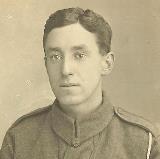
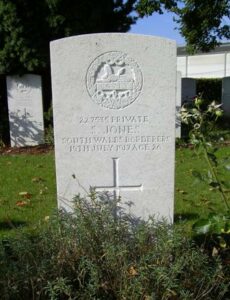
William Arthur Killa, Private, 4301, Welsh Regiment. William was born in Pendine on 30 October 1894, the son of John and Esther Killa. The family was from Laugharne, but had resided at Pendine for several years, before moving to Alltycnap Road, Carmarthen. Williams’s Grandparents stayed in Laugharne. William enlisted into the 1/4th Battalion of the Welsh Regiment in August 1914. The 1/4th was a territorial Battalion, and it formed part of South Wales Brigade. On 17 April 1915 it was attached to 159th Brigade, 53rd Division and on 8 October 1915 amalgamated with 1/5th Battalion forming 4/5th Welsh Composite Battalion. In July 1915, the 53rd Welsh Division was shipped to Egypt and there they trained for the Gallipoli Campaign. On 9 August 1915, the Division landed at Suvla on Gallipoli. The day after landing on the hostile shores of Gallipoli, William was killed in Action. He was just 20 years old and had seen just one day of fighting. He is remembered on the Helles Memorial in Gallipoli. William is not commemorated at Laugharne, but at Llangynog.

Charles William Wykeham King, Company Sergeant Major, 76003, Artist’s Rifles. Charles was born in Wykeham, Fareham, London. Charles had been educated at Llandovery College from 1895 to 1901, and was then resident at the Vicarage in Laugharne. He married Ida Schroeter before moving to London, where they lived at 80, Shrewsbury Road, New Southgate. Charles served as a Company Sergeant Major in the 28th Battalion (Artists Rifles), the London Regiment. The Artists Rifles Battalion was an elite unit, used as an Officer Training Corps, and by November 1915 was in France. They absorbed the 2nd/28th Battalion and by March 1916 were at Hare Hall, Romford. In 1917 the Battalion was reformed and in June became part of 190 Brigade, 63rd Royal Naval Division. The first major Front Line battle faced by the Artists Rifles was to be the Second Battle of Passchendaele. Charles was killed in action by German Artillery Fire just before that fateful attack on Passchendaele Ridge, on 28 October 1917. He is buried in Tyne Cot Cemetery, Belgium. Charles had been awarded the Bronze Medal for Valour by the Italian Government (London Gazette 26 May 1917). Ida had remarried by September 1919, and lived with her new husband Sydney Lane.
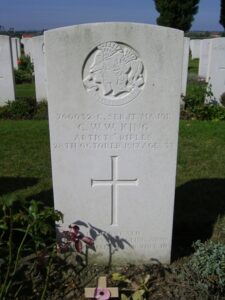
Hugh Charles Lennon, Master Gunner, 24325, Royal Garrison Artillery. Hugh was the son of William and Frances Lennon, of 37, Croydon Road, Elmer’s End, Beckenham, Kent. He married Justina Sophia Griffiths, of Laugharne, at Battle in March 1910, and the couple lived at 2, Station Road, South Cerney, Glos. Hugh was a regular soldier, and must have lived at Llanelli at some time. During the Great War he was attached to the Royal Artillery Staff in India, and died there on 6 June 1918 after becoming ill. Hugh was 35 years old, and is buried at Peshawar. He is also commemorated on the Delhi Memorial (India Gate), India. He was the holder of the Long Service and Good Conduct Medal. Hugh is not commemorated at Laugharne, but at Llanelli.
Martyn Tulloch Vaughan Lewes, Second Lieutenant, Welsh Regiment. Martyn was born in Marylebone in June 1895, to Captain Price Vaughan Lewes and Anne Josephine Lewes. Martyn was educated at Harrow, and afterwards studied at the Royal School of Mines, Camborne. After qualifying as a Mining Engineer, he travelled to Canada for a years experience before touring the world. Following the family traditions, his mother’s father was Colonel J. G. M. Tulloch of the Royal Scots, and his father’s father was Colonel John Lewes, the Hero of the Redan, Martyn joined the Officer Training Corps, and on 15 August 1914, was gazetted as a Second Lieutenant into the 3rd Battalion, Welsh Regiment. The 3rd Welsh was a Reserve Battalion that had been raised in Cardiff in August 1914 and stayed home throughout the war, acting as a feeder for other battalions of the Welsh Regiment. After training, Martyn was posted to the Monmouthshire Regiment in France. He was wounded at Ypres soon after moving to the Front, and went home on leave. He then decided to join the Royal Flying Corps, where he trained as an Observer. Martyn was posted to 25 Squadron, who were based in France from February 1916. He is reported in the Harrow Roll of Honour that he was a Pilot, and had shot down three German aeroplanes, but at the moment there is no other evidence of this to be found. Martyn was reportedly taking part in a training flight on 15 July 1916 as Pilot of an F.E.2b aeroplane. He got lost in fog over German lines, and when the fog cleared his aeroplane was hit by ‘Archie’, which damaged the landing gear. After returning to Bailleul and circling over the ground for a while, wondering how to get down, Martyn flew low to the ground and jumped out of the aeroplane. In the fall he broke his legs and suffered internal injuries, and was rushed to the Hospital at Bailleul for treatment. He sadly died of his injuries on 22 July 1916, and was buried at Bailleul Communal Cemetery Extension, France. He was just 21 years old. Martyn has no real ties to Laugharne, but his father Pryce was a regular visitor, who was well known in the Township.
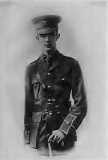
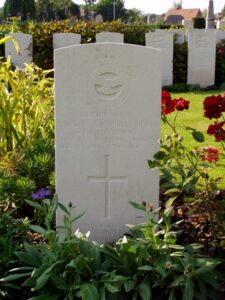
Price Vaughan Lewes, Captain, Royal Navy. Price was born on 27 February 1865 at Llanfear, Felinfach, Cardiganshire, to Colonel John and Mary Jane Lewes. At the tender age of 13, Price joined the Royal Navy, serving aboard the training ship HMS Britannia, under Captain E. Kelly. On 23 July 1880, Price was posted to HMS Achilles, and just two months later, at the age of 15, he was promoted to Midshipman. During August 1893, Price had been promoted to Lieutenant, and was the third most senior officer aboard HMS Blanche, which was stationed at Zanzibar. He gained the award of the Distinguished Service Order for his gallantry here. On his return home, Price married his fiancée, Anne Josephine Tulloch at Chester, on 30 April 1894, and a year later, Anne gave birth to their son Martyn Tulloch Vaughan Lewes. From this period onwards, the family often came to Laugharne when Price was on shore leave, spending their time relaxing at Hillside, the home of his friend Samitt Willimott and his family. Price became very well known in Laugharne, which had become a haven for high-ranking military officers at this time. By 1897, Price had gained command of the newly launched gunboat HMS Hazard, and took part in a Victoria Cross action at Crete. For his fine leadership in this affair on Crete, Price was promoted to Commander, by order of Her Majesty Queen Victoria. On 30 June 1905, Price was promoted to Captain in the Royal Navy, and afterwards took command of the Battleship HMS Superb, which was launched in 1909. The Superb was a Bellerophon Class Dreadnought Battleship, with a main armament of ten 12″ guns. During 1913 Price received the CB as part of the King’s Birthday Honours, to go with his Distinguished Service Order, and his Africa General Service Medal with Juba River Clasp. At the outbreak of the Great War, HMS Superb was part of the British Home Fleet. Due to the outbreak of hostilities, the Royal Navy reorganised its fleets, and the Superb became part of the 4th Battle Squadron of the Grand Fleet, which was commanded by Admiral Sir John Jellicoe aboard HMS Iron Duke. Price was on sick leave in Laugharne, but promptly resumed command of his ship HMS Superb. At the beginning of November 1914, Price was invalided to Devonport Naval Hospital, where he sadly died at the age of 49, on 10 November 1914. He lies buried in the Plymouth (Western Mill) Cemetery, Devon. Price is not commemorated in Laugharne.
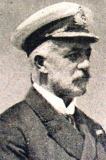
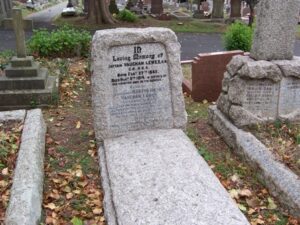
George Lewis, Chief Stoker, 293940, Royal Navy. George was born in Gosport Street, Laugharne, on 6 May 1880, the son of Henry and Elizabeth Lewis, who were both cockle merchants. George became a Farm Labourer, until on 26 December 1899, he signed up at Devonport, for 12 years in the Royal Navy. After serving on a succession of training ships, HMS Vivid, Vulcan, Hood, Caesar & Indus, and was aboard HMS Leande when War broke out. George passed for Chief Stoker on 9 February 1917, whilst serving aboard HMS Dido, then spent three months ashore at Devonport with HMS Vivid II. On 15 February 1918, George transferred aboard the Battleship HMS Roxburgh. From September 1916 she served on the North America and West Indies Station until the Armistice. She rammed and sank the German U-Boat U89 while escorting a convoy off the coast of Northern Ireland on 12 February 1918. Roxburgh was assigned to Atlantic Convoys, escorting US troopships to Great Britain. On 20 September 1918, she was at anchor in Quebec, when George slipped and fell off a trestle bridge and was killed. George was given a Military Burial by his shipmates in the Quebec City (Mount Hermon) Cemetery, and they paid for a stone on his grave. George left behind a widow at Devonport, Elizabeth Jane Lewis, of 18, Horne Road, Ilfracombe, Devon. Nothing more can be found of Elizabeth. George is not commemorated at Laugharne.
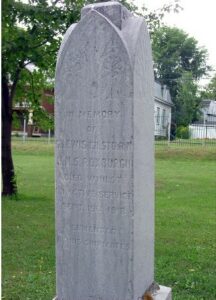
Clifton Malet Lucas, Second Lieutenant, Welsh Regiment. Clifton was a man with a thirst for travel. He was born in Sydney, New South Wales on 13 October 1885, the son of Colonel Hugh Claude Edward Lucas and Emelie Lucas (nee Tehlencker). His great grandfather was from Hillside, Laugharne. He moved to Teignmouth in Devon. He had then served with the Punjabi Rifles before emigrating to Canada, working as a Land Surveyor. At the outbreak of war he enlisted at Valcartier, Canada, into the 7th Canadian Infantry Battalion, and embarked for Britain. Clifton was then commissioned Second Lieutenant into the 4th South Wales Borderers, and saw service at Gallipoli, being wounded at Suvla Bay. On 1 April 1916 Clifton became a full Lieutenant, and was attached to the 15th Welsh in France. He was killed in action soon after, during the fighting at Mametz Wood on 10 July 1916. Clifton has no known grave and is commemorated on the Thiepval Memorial. Neither Clifton nor his brother Malcolm are commemorated in Laugharne.
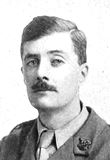
Malcolm Hugh Lucas, DSO, Lieutenant Colonel, Indian Army. Malcolm was born in Aden on 2 June 1882, the son of Colonel Hugh Claude Edward Lucas and Emelie Lucas (nee Tehlencker). His great grandfather was from Hillside, Laugharne. He was educated at the Royal Military College, Sandhurst prior to being commissioned into the Indian Army on 18 January 1902. In 1913 he married Eveleen Anne Isabella Robson in Bengal. He commanded the 37th Lancers (Baluch Horse) in India towards the end of the war, then took the regiment to Mesopotamia, to help suppress the 1920 Iraq Revolt. He died of heart failure in Iran on 2 August 1920, and is buried in Tehran War Cemetery, Iran. Neither Malcolm nor his brother Clifton are commemorated in Laugharne.
Domingo Mobile, Able Seaman, Mercantile Marine. Domingo was a Venezuelan who served with the Mercantile Marine aboard the S.S. Sofie, a London registered merchant steamer. On 2 February 1918 she was en route from Jersey to Cardiff in ballast when she was attacked in the Bristol Channel by the German submarine U-101. She was sunk by gunfire from the surfaced U-Boat with the loss of eight lives. Domingo was 39 years old when he died during the attack. His bullet-ridden body was discovered in a lifeboat which had washed ashore on Laugharne Sands, and he was buried in St. Martin’s Churchyard, Laugharne on 13 February 1918. Domingo is currently commemorated on the Tower Hill Memorial, London, but as a result of my research and the presentation of the evidence from myself to the CWGC that he is buried in Laugharne, the CWGC have erected a Special Memorial in the Churchyard.

John Ewart Morris, Private, 25811, Welsh Regiment. John was born in Laugharne in 1886, the son of Jonah and Miriam Morris, of Clyde House. He worked as a grocer at Brynamman prior to the war and enlisted into the 17th Battalion, Welsh Regiment on 12 January 1915. The battalion was a bantam unit, made up of men below the standard minimum height for army service and was attached to 119 Brigade, 40th Division. The division landed in France in June 1916 and saw service on the Western Front for the remainder of the war. John became ill during his first winter in France and was invalided out of the army on 18 February 1917 after having been diagnosed as suffering from tuberculosis, which had been aggravated by his service. He returned home to Laugharne, where he died on 7 April 1923, aged 36. John is not commemorated by the CWGC because he died after the cut-off date for WW1 commemorations. He is not commemorated in Laugharne.
John Herbert Morris, Second Lieutenant, Welsh Regiment. John was the youngest son of Watkin Morris, of 10, The Terrace, Cwmavon, Glamorgan, the Manager of the Duchy Colliery, Cwmavon. His uncle was Herbert Eccles, Manager of the Briton Ferry Steelworks, Glamorgan, who resided at Broadway Mansion, Laugharne, and John was a frequent visitor. John was educated at Llandovery College from 1904 until 1911, and in 1915 was commissioned into the 20th Battalion, Royal Welsh Fusiliers. He later transferred into the 6th Battalion, Welsh Regiment, which was the Pioneer Battalion to the 1st Division. They were used to clear the battlefields after the July battles on the Somme. It was while engaged upon this work near Fricourt that John was killed on 21 September 1916. He was 25 years old, and is buried at Flatiron Copse Cemetery, France. John is not commemorated at Laugharne.
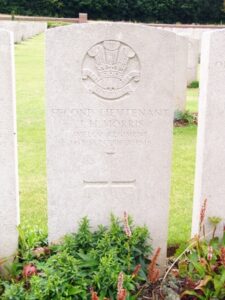
George Fison Muller, Major, Royal Marine Light Infantry. George was born on 28 May 1876 in Horsforth, Yorkshire, the son of Harry and Agnes Muller. His parents later lived at 12, West Park, Eltham, London. George married Katherine Margaret Berkeley of Rawdon, Yorkshire on 4 October 1906. Georges Aunt, Mrs. Brayshay, lived at the Glen, in Laugharne, and George was a frequent summer visitor to the Glen, becoming well known and respected in Laugharne. On 1 September 1894, George followed in the footsteps of his Uncle, Commander Brayshay of the Glen, Laugharne and joined the Royal Naval College at Greenwich. When war was declared George was on leave, and had just arrived at Laugharne with his wife when he received a telegram, recalling him to the forces. He subsequently joined the 10th (Plymouth) Battalion, Royal Marine Light Infantry, which formed part of the Royal Marine Brigade, Royal Naval Division. The Royal Naval Division landed at Dunkirk on 20 September 1914, with orders to assist in the defence of Antwerp, but were withdrawn to England on 11 October 1914. After a lengthy period of refit, the Division moved to Egypt preparatory to the Gallipoli campaign, and on 25 April 1915, landed at Gallipoli and carried out a diversionary attack on Bulair. By dawn on 28 April, some 20,000 British troops had landed, facing only 6,300 Turkish defenders, and began the First Battle of Krithia. Terrible fighting raged for days, with the Allies and the Turks suffering thousands of casualties. It was during this ferocious Turkish onslaught that George was mortally wounded. He died aged 39, on 1 May 1915, and is buried in Lone Pine Cemetery, Gallipoli. George is not commemorated at Laugharne.
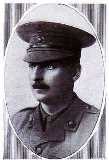
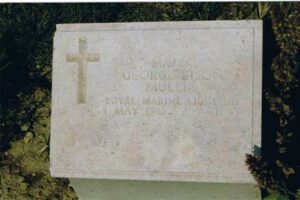
Samuel Robert Nesbitt, Lance Corporal, 3/12065, South Wales Borderers. Samuel was born in Tenby in 1887, the son of Samuel Robert Nesbitt, a soldier from Liverpool, and Alice Ann Nesbitt (nee Jenkins), a domestic servant from Laugharne. Alice died just after Samuel’s birth, whilst his father died of pneumonia whilst based on Guernsey in 1889, leaving Samuel and his elder brother Joseph orphaned. With no surviving family left in Laugharne, Samuel and Joseph were raised by Thomas and Susan Williams in Tenby. By 1911 Samuel was working as a groom at The Heath, Cardiff, then by 1913 he had moved to 54, The Watton, Brecon, where he had found work as a groom. On 27 April 1913 Samuel married Lilian Rose Eldred of Brecon and the couple had two daughters over the coming years. Samuel enlisted into the South Wales Borderers at Brecon on 28 October 1914, stating that he had four years prior service with the Pembroke Yeomanry, and was initially posted to the 3rd Battalion, South Wales Borderers. On 20 September 1915 he was posted to the 50th Provisional Battalion, then on 30 December 1916 was drafted to France, joining the 2nd Battalion, South Wales Borderers, which was on the Somme, attached to 87 Brigade, 29th Division. Within weeks of his arrival, Samuel was hospitalised, suffering from scabies and eczema, commonplace in the trenches, and by the time he rejoined the battalion, the division had moved to the Arras sector. Samuel would have then taken part in the ferocious assault carried out by the division against Monchy-Le-Preux, during the Battle of Arras, but soon afterwards scalded himself whilst cooking at the officers mess, during a brief respite out of the line. Samuel was treated at Arras before being sent to the 2nd Australian General Hospital at Wimereux, where he was found to be suffering from pthisis. He was sent back to England for treatment at a Military Hospital at Endells Street, London, but with no antibiotics available to cure his condition at that time, he was discharged from the army as medically unfit on 18 September 1917 and returned home to Brecon. Samuel’s health continued to deteriorate after being discharged and he died of pthisis at Brecon on 15 January 1921. The 35-year-old was buried in Brecon Cemetery. His widow, Lily, also lost her brother, Bertie Eldred in 1920, as a result of sickness contracted during the war. Samuel is not commemorated at Laugharne, Tenby nor at Brecon.
John Thomas Parry, Lance Corporal, 1468, Welsh Regiment. John was born around 1892, to Charles and Lydia Parry, in Laugharne. The family later moved to Penvilla road, Swansea. He had an older sister Margaret, two younger sisters, Florence and Clarice, a younger brother Charles, and another brother Frederick. John enlisted into the 2nd Battalion, Welsh Regiment, five months before the war broke out. The 2nd Battalion were in Bordon on 4 August 1914, at the outbreak of war, becoming part of 3 Brigade, 1st Division and moved to France. Here the Division took part in most of the major actions of the war, at the Battle of Mons in the early stages, the Battle of the Marne, the Battle of the Aisne, actions on the Aisne heights, action of Chivy, and the First Battle of Ypres. Whilst still a Private, John attempted to rescue a wounded comrade whilst under heavy fire, but was wounded in this gallant rescue attempt and had to be evacuated to hospital at Rouen. For this act he was recommended for the Distinguished Conduct Medal, but the army hierarchy deemed not to honour the recommendation. After he had recovered from his wounds, John was promoted to Lance Corporal, and rejoined his battalion, which was preparing to take part in the Battle of the Somme. The division took part in the Battle of Albert and the Battle of Bazentin. John was wounded in the foot on 25 July, being partially buried in a blown up trench, but with the help of his comrades, he was dug out and rejoined the action, before being fatally wounded the following day, during the attack on Munster Alley on 26 July 1916; the day after the Battle of Pozieres Ridge began. John’s body was never recovered and so he is remembered on the Thiepval Memorial, France.
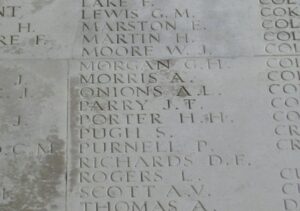
William Neville Hurt Peel, Private, Canadian Infantry. William was born on 24 February 1884, to Edmund and Winnie Hurt Peel, of Fern Hill, Laugharne. William had two brothers, Francis, the eldest, joined the South African Mounted Police, and Ralph, the youngest, who had emigrated to Canada. He also had a younger sister Dulcie, who was born in 1898 at Fern Hill. William was an adventurer, like his brothers, who ran off with a fair girl, and made his way to South Africa, where he spent two years serving with the 1st Brabant’s Horse during the Boer War. He then made his way to Canada, enlisting in the 184th Overseas Battalion, Canadian Infantry, on 21 February 1916. His wife, Harriet Ann Peel, was named as his next of kin and was living at 187, Hargrave Street, Winnipeg, Canada. During November 1916, William embarked on the troop ship SS Empress of Britain, and arrived in England on 11 November 1916. He was taken on strength at Shorncliffe on 12 November, then spent a short spell home in Laugharne on leave, before being transferred into the 8th Manitoba Battalion (Little Black Devils) on 30 November and sent to the Western Front on 1 December 1916. The Little Black Devils were part of the Canadian forces that took part in the famous Battle of Arras which started on 9 April 1917. The Canadians formed part of the 1st Army led by General Sir Henry Horn. Their part in the battle was to capture Vimy Ridge, where the famous Canadian war memorial now stands, and the 8th was used as a Reserve Battalion. The Battle for Vimy Ridge was almost over when the Battalion was brought into the action. On 25 April they were sent to the areas around Bentata and Douai, relieving the 1st and 2nd Battalions in reserve trenches. On 27 April orders were given to attack the village of Arleux-En-Gohelle. By the next day the village had been taken-the War Diary states that resistance was stubborn, with hand-to-hand fighting taking place in the village. William was reported missing in action on 28 April 1917 and it wasn’t until the 26 May that he was officially listed as being killed in action. He was 33 years old. William is buried at Orchard Dump Cemetery, France.

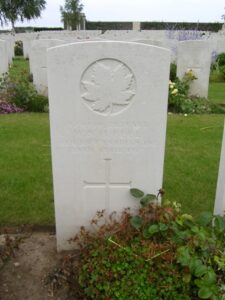
James Stanley Phillips, Private, 39605, South Wales Borderers. James was born in 1897 to David and Anne Phillips, of Parcnwc, Llanstephan. James’s mother Anne was from Laugharne, the daughter of Mr and Mrs Thomas, Castell-Toch. James spent a lot of his childhood with his Grandparents at Castell-Toch, and was well known in Laugharne. Early in 1917, James was drafted into the army, where he became a Private in the 2nd Battalion, South Wales Borderers, which formed part of 87 Brigade, 29th Division, and had landed at Marseilles on 29 March 1916 after a torrid spell at Gallipoli. The Division had fought through the Battle of the Somme in 1916, then through the Battles of the Scarpe, near Arras, through the beginning of 1917. On 7 June 1917, the Flanders Offensive, a brainchild of Sir Douglas Haig, was begun around Ypres. The following battles were to become known as ‘Third Ypres’ or ‘Passchendaele’. On 16 August 1917, the Battle of Langemarck began. This area, just North of Ypres, had become a hellhole. The continuous bombardment of the German Front Lines had turned the battlefields around Ypres into a quagmire of foul, sticky mud, full of the debris of three years of non-stop fighting. James, aged just twenty years old, was killed in action that day. As happened to so many other poor souls that fought in that area, his body was lost in the mud, and so he is commemorated on the massive Tyne Cot Memorial, Belgium. At the very time that James lost his life, his mother also had the agony of her elder brother John Thomas in an Army Hospital in Birmingham having his leg amputated after a terrible wound suffered in France. James is not commemorated at Laugharne but at Llansteffan.
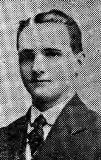
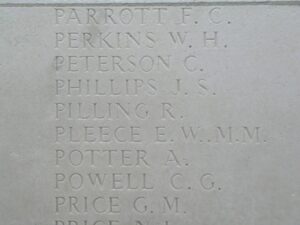
Richard John Pile, Private, 34189, South Lancashire Regiment. Richard was born in 1898, in Llanelli, the youngest son of Charles and Alvie Pile and had 4 sisters, Alvie, Maisy, Mary and Alexandra, and a brother Thomas. By 1901 the family were living at Broadway Mansion, Laugharne. Richard volunteered into the Welsh Regiment, and was then transferred into the 8th Battalion (Prince of Wales Volunteers) South Lancashire Regiment, which formed part of 75 Brigade, 25th Division, and moved to France in September 1915. The Division took part in some of the most horrific battles of the war, at the Battle of Albert, the first phase of the Battle of the Somme, in 1916, at the Battle of Bazentin, where 4,000 Germans were taken captive on one day, and at the Battle of Pozieres, alongside the Anzacs. The battle of the Somme was raging on still since its start on 1 July 1916, and on 21 October 1916, while attacking the German lines at Regina Trench. His body was never recovered, and he is remembered on the Thiepval Memorial, France.

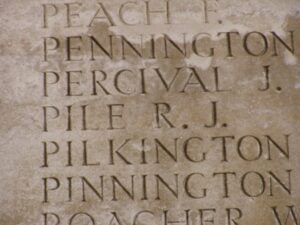
David Albert Price, Private, 26678, Machine Gun Corps (Infantry). David was the son of George and Ann Price. His mother, née Ann Jones, was from Laugharne. David married Eva Amelia Pearce in 1914 and the couple resided at 138, Ynyscnon Road, Trealaw, Dinas (Rhondda). David enlisted into one of the two Rhondda Battalions of the Welsh Regiment at Tonypandy early in the war, and trained at Rhyl before being transferred to the 38th (Welsh) Division Machine Gun Battalion, which landed in France with the division on 2 December 1915. He survived the divisions epic battles at Mametz Wood in July 1916 and Pilckem Ridge in July and August 1917. The division moved back to the Somme in April 1918, as a result of the Germans breaking through the British lines there, and held the line in the Aveluy Wood sector until August 1918 when it launched its part in the opening of the 100 days offensive. David was killed in action mid-way through this final offensive of the war, during the capture of Villers-Outréaux, following the divisions crossing of the Hindenburg Line. He was 29 years old and is buried in Prospect Hill Cemetery, Gouy, France.
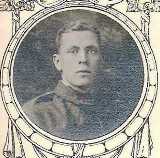
Thomas Henry Price, Private, 192312, Canadian Infantry. Thomas was born in Rhayader, Mid Wales, on 16 August 1891. His mother was Miriam Price David, who was married for the second time, to William David, a butcher from Laugharne who owned the Browns Hotel. Thomas had an elder sister Annie Price, two younger brothers James and John Price, and a stepsister Miriam David. The family emigrated to Canada at the turn of the Century, and lived at 277, Carlton Street, Toronto, Ontario. Thomas enlisted on 13 August 1915, into the 92nd Overseas Battalion, Canadian Infantry, before being posted to the 15th Battalion (Royal Highlanders), Canadian Expeditionary Force. Thomas arrived in England on the troopship SS Empress of Britain on 29 May 1916, and on 17 July 1916 joined his Battalion in France. The 13th Battalion had fought at Ypres during April 1915, where gas was used for the first time, and also saw heavy fighting at Festubert, Messines, Bailleul, and Givenchy, before moving to the Somme. During September 1916, the 13th Battalion marched from Warloy to billets in Herissart. From there they took over the front line trenches near Courcelette. Three Companies of the 13th Battalion held the front line trench until the end of the month, suffering over 231 casualties in the month. Thomas was wounded on 27 September 1916, and was brought back to the 3rd Canadian Casualty Clearing Station at Albert for treatment. He died of his wounds that same day, and is buried at Albert Communal Cemetery Extension, France.

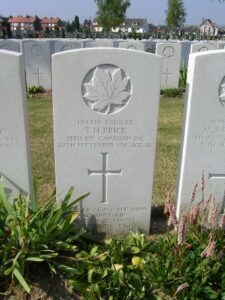
Samuel George Rees, Private, 28765, Herefordshire Regiment. Samuel was born at Angle, Pembrokeshire in 1899, to John and Elizabeth Rees, of Court House. When war broke out, Samuel was living in Laugharne, and he enlisted at Carmarthen into the Army. Samuel was posted to the 1/1st Battalion, Hereford Regiment, which was attached to 158 Brigade, 53rd (Welsh) Division. The Battalion embarked at Devonport on the SS Euripides on 16 July 1915, and landed on C Beach, at Suvla Bay, Gallipoli on 9 August 1915, immediately taking part in a brave attack on the Turkish Lines. After the Allied forces had been withdrawn from Gallipoli, the 53rd Division fought in Egypt and Palestine. After a hard fought campaign, they had the Turks on the run in the Middle East, and with the Allies facing a shortage of men on the Western Front, after the German Offensive of March 1918, the Battalion left the Division, embarking on 1 June 1918 for France. On 22 June, they landed at Taranto, then arrived in France on 30 June, becoming attached to 102 Brigade, 34th Division. The Division were at this time fighting alongside the French XXX Corps in Champagne, where they took part in the Battle of the Marne, 1918, and the Battle of the Soissonais and the Ourcq. They then moved to Flanders, where they took part in the advance in Flanders, culminating in the Battle of Ypres, 1918, and the Battle of Courtrai. It was during the Battle of Courtrai that Samuel was killed, and he was buried where he fell. His body was relocated after the war, and Samuel now lies in Hooge Crater Cemetery, Belgium. Samuel is not commemorated at Laugharne, but at Angle.
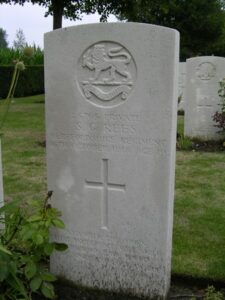
Daniel John Richards, Private, 76031, Welsh Regiment. Daniel was born around 1900 in the Brill, Laugharne, the son of David and Margaret Richards. Daniel had an older brother Thomas and two sisters, Mary Ellen and Annie. Daniel joined the 4th (Reserve) Battalion, Welsh Regiment on 1 June 1918. Daniel’s enlistment form shows him to have a history of Bronchial problems, but this was not deemed bad enough to stop his enlistment. On 2 June 1918, Daniel was posted with the 4th Battalion to Cardiff, and then was attached to the 10th Battalion, London Regiment, at Pembroke Dock from 2 September 1918. Daniel never served overseas, but stayed at home with the Garrison force. Daniel died aged just 18 on 9 December 1918 of cirrhosis of the liver in Cambridge Hospital, Aldershot. It was just three weeks after the Armistice was signed. He was buried in St. Martin’s churchyard in Laugharne on Saturday 14 December, near the West boundary-about twenty feet from the entrance to the Church.
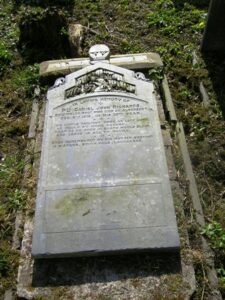
George Richards, Driver, 19999, Royal Field Artillery. George was the eldest son of George and Sarah Richards, of Treventy Farm, Llanfihangel Abercowin. George’s father was born in Laugharne in 1843, and along with his brother Richard Richards and both their wives, moved around the country following various jobs. In 1887 George Richards Junior was born in Herefordshire. George had a younger brother John, and two elder sisters, Ida and Amy. The family moved to Treventy Farm around 1895. George enlisted as a Driver into the Royal Field Artillery, and was posted to the 42nd Battery, 2nd Brigade, and landed in France on 5 December 1915. The Battery later became attached to the 29th Division, which had been evacuated from Gallipoli and sent to France, landing in Marseilles on 29 March 1916, and the entire Division moved to the Somme. They fought in the Battle of the Somme in 1916, taking part in the opening assault on Beaumont Hamel on 1 July 1916, then the Battle of Arras in March 1917, before being sent to Belgium, to the infamous Ypres Salient, to form part of the build up to the Battles of Third Ypres. Except for a brief period fighting at the Battle of Cambrai, the Division stayed in the Ypres sector. April 1918 was to see them playing a big part in the Battle of Messines, and the Battle of Mount Kemmel, when the Germans launched their desperate attempt to finish the war before the rapidly expanding American Army could be deployed. In the middle of this desperate ‘backs to the wall’ defence of their positions around Ypres, George was killed in Action on 27 May 1918. He was buried in Hagle Dump Cemetery, Elverdinghe. George is not commemorated anywhere locally.
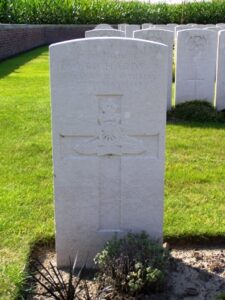
James Richards, Private, 41052, Hampshire Regiment. James was born in Haverfordwest on 6 July 1895, the son of James and Elizabeth Richards, of Coltesmore Lodge, Prendergast. In September 1915 he married Mary Ann Brown, the daughter of David and Elizabeth Brown of Frog Street, Laugharne. They briefly set up home in Laugharne, before James enlisted into the army, and was posted to the 2/5th Battalion, Hampshire Regiment. James joined the battalion in Egypt, where it was attached to 232 Brigade, 75th Division. The Division had formed in Egypt in March and April 1917, and served in Egypt and Palestine, taking part in the Third Battle of Gaza during November 1917, then the Capture of Junction Station, the Battle of Nabi Samweill and the capture of Jerusalem. At some stage around the time of the Battle of Nabi Samweill, James fell ill with appendicitis, and was hospitalised at the 21st General Hospital, Alexandria. James passed away on 9 December 1917. His bereaved widow, Mary Ann had already suffered the heartbreak of the death of their twenty one month old daughter Florence Martha Richards who had passed away during September 1917 without James ever having the chance to see his daughter. James was buried in Alexandria (Hadra) War Memorial Cemetery, Egypt. Mary went on to remarry, and in October 1918, she married her next-door neighbour, George Brown. George, or Georgie, as he was known in Laugharne, was to become my Grandfather. It is strange how out of sad events such as the death of James Richards, a whole family was created that would never have existed had he not died that day in Hospital in Egypt. James is not commemorated at Laugharne but at Haverfordwest.
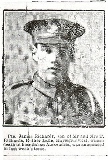
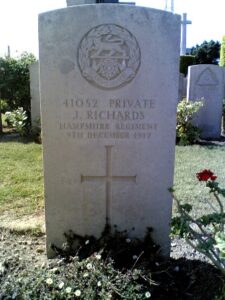
Thomas Sheridan, Private, 2677, Gloucestershire Regiment. Thomas was born in Newcastle-under-Lyme, Staffordshire in 1860, the son of Martin and Alice Sheridan. He was a long serving soldier, who had enlisted on 17 May 1884 into the North Staffordshire Regiment and had also served with the Middlesex Regiment prior to retiring, and came to Carmarthen to work in the Towy Iron Works. Following the outbreak of war, Thomas re-enlisted at Carmarthen into the army on 9 September 1914, lying about his age, and was posted to the Gloucestershire Regiment. He joined the 3rd Battalion, Gloucestershire Regiment at Bristol two days later. Thomas was found to be unfit for military service, probably due to his age, and was discharged from the army on 7 May 1915, returning to 68, Richmond Terrace, Carmarthen, where his wife Priscilla had set up home. The couple then moved to Laugharne, and lived at Merry Vale, Halfpenny Furze. Thomas died of heart disease on 29 October 1921, aged 61. Nothing further is known of him, as he is not commemorated by the CWGC. Thomas is not commemorated on any local war memorial.
Lionel St. George Mordaunt Smith, Second Lieutenant, Royal Inniskilling Fusiliers. Lionel was born on 23 April 1896 in Rugby, Warwickshire, the son of Mordaunt Kirwin and Ethel Mordaunt Smith. The family later lived at Milton Bank, Laugharne, after Mordaunt had retired from a distinguished military and banking career. Lionel was educated at Elstree School from May 1906 until July 1910, then at Charterhouse until 1913, where he served as a Sergeant in the Charterhouse O.T.C. Lionel was admitted into the Royal Military Academy during the November to December 1913 intake, and was commissioned into the Royal Inniskilling Fusiliers, where he served in the 2nd Battalion, which was attached to 12 Brigade, 4th Division. They were then transferred to 5 Brigade, 2nd Division on 26 January 1915. The Battalion was at Montmorency Barracks, Bethune, at the beginning of May 1915, then moved to positions at Richebourg. From 9 May they remained in the Richebourg area, alternating time in the trenches with rest days. On 12 May they were posted to a front line trench, suffering several casualties whilst waiting for the order, which arrived on the night of the 15/16 May, to attack the German lines, during the opening assault of the Battle of Festubert. The battle began with the British artillery bombardment on 13 May 1915, with 433 guns firing onto the German lines over a 5,000 yard front. After two days of intense bombardment, the infantry units were in position, and on the night of the 15/16 May 1915 the battle started. 6 Brigade attacked on the left flank, with 5 Brigade attacking in front. However 5 Brigade ran into heavy machine gun fire, and even though some men of the 2nd Inniskillings reached the German line, the majority were cut down in no-mans land. The Battalion lost four Officers killed, ten wounded and four missing during the assault. The other ranks amounted to 39 killed, 371 wounded and 239 missing. Well over half of the battalion had been lost that night. Lionel was killed during the attack, as an officer he would have been one of the first ‘over the top’ and would have been the first hit. He was just 19 years old. His body was never recovered, and so he is remembered on the Le Touret Memorial, France.
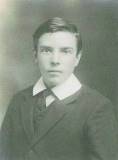
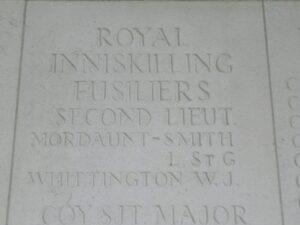
Richard Douglas Stealey, Leading Seaman, Z/191, Nelson Battalion, Royal Naval Division. Richard was born in London on 25 May 1894, the son of Captain John Stealey, a Master Mariner, and of Ada Page Stealey. He had an elder sister Mary Page, who was born in Laugharne, and they lived in Sunny Hill, Holloway Road, Laugharne. Richard was a member of the Royal Naval Volunteer Reserve, and was called up as soon as war broke out, being drafted into the Nelson Battalion, Royal Naval Division. His service number shows that he was in the London Division RNVR. His father had died by now, and his widowed mother had moved the family to Attleborough Cottage, the Tilt, Cobham, Surrey. The Royal Naval Division had been made up of members of the Royal Navy who had no ship to serve on, and had been turned into a land force, akin to the modern day Royal Marines. After an unsuccessful attempt to hold the Port of Zeebrugge, the Royal Naval Division was sent to the Mediterranean, before taking part in the Gallipoli Landings, landing at Anzac beachhead on 29 April 1915. On 3 May 1915 the Royal Naval Division was in the middle of a spell of heavy fighting at Krithia. It was during this terrible fighting that Richard was shot in the head, but managed to walk back to a first aid post from where he was evacuated, by Hospital ship, to Alexandria. Richard died of his wounds aged just 20 on 7 May 1915 and was buried in the Alexandria (Chatby) War Memorial Cemetery, Egypt.
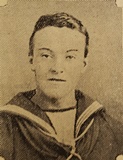
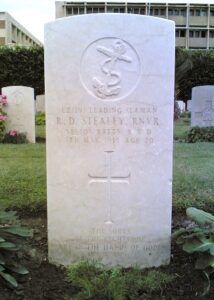
Arthur Goring Thomas, Private, 39626, South Wales Borderers. Arthur was the son of Samuel and Tabitha Thomas, of Holford House, 2, Crewallis Street, Bridgend. He enlisted at Cardiff into the army and was posted to the 2nd Battalion, South Wales Borderers, which was in France attached to 87 Brigade, 29th Division. He probably joined the battalion as a reinforcement after its abortive assault on the strongly held German position at Y-Ravine on 1 July, which saw the battalion virtually annihilated. The battalion did not return to the line until the latter stages of the Somme offensive, moving into positions near Lesbouefs on 16 November. After suffering a cold winter on the Somme, the battalion moved back into the front line at the beginning of February 1917. During most of 4 February 1917 the Germans kept up a heavy bombardment of the section of line held by the 2nd SWB, causing heavy casualties among the battalion. Arthur was one of those killed during the day. He was 22 years old and is commemorated on the Thiepval Memorial, France. At some time after the war his parents moved to Woodford, Broadway. His father died there in 1931 and is buried in St. Martins Churchyard, Laugharne and Arthur is commemorated on his fathers headstone. The engraving was discovered by Anthony Bradshaw, who kindly sent me a photograph of the grave. Arthur is not commemorated at Laugharne, except on this gravestone.
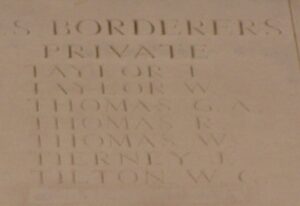
Brythonfryn Gwyn Thomas, Private, 1972, Royal Army Medical Corps. Gwyn was the son of John and Mary Jane Thomas, of the Blue Boar Public House, St. Clears. He enlisted at Swansea into the 1/3rd Welsh Field Ambulance, Royal Army Medical Corps. The 1/3rd Field Ambulance served with the 53rd (Welsh) Division, and landed at Suvla Bay on 6 August 1915, where they set up their stations. These men of the Field Ambulance were soon to be sorely tested. Over the coming days, they became swamped with hundreds, if not thousands, of casualties from the first days fighting during the Battle of Sari Bair. Conditions must have been dreadful, as the battlefields were already sown with the dead of previous assaults, and the bloated corpses in No Man’s Land played host to millions of flies, which infested everywhere, sowing their germs and diseases, adding to the misery of the men on the peninsula. Sadly Gwyn was wounded during this terrible time, although the details are not known, just days after landing, and he was evacuated off the Peninsula, onto a Hospital Ship moored in Suvla Bay. Gwyn died of wounds on-board the Hospital Ship on 15 August 1915. He was 23 years old, and was buried at sea, and so he is remembered on the Helles Memorial, Gallipoli. Gwyn is commemorated on the War Memorial at Bwlchnewydd Chapel, Laugharne and not on the main memorial.

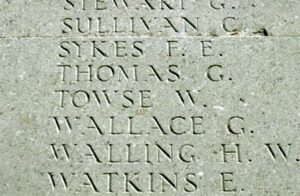
John Arloe Edward Thomas, Leading Carpenter, 345555, Royal Navy. John was born on 27 August 1880 at Horsepool Farm, Laugharne, the son of Charles and Martha Thomas. When Charles retired from farming at Horsepool, the family moved to number 17, St. Thomas’ Green, Haverfordwest. John was already a veteran in the Royal Navy at the outbreak of the Great War, after having enlisted in September 1902, and by the outbreak of war was aboard HMS Hawke. Here he served with another local man, Engineering Lieutenant Commander Thomas Morgan David, of Laugharne. HMS Hawke was an Edgar class cruiser, which saw service in the war as a converted depot ship for destroyers and submarines. John was killed when Hawke was torpedoed and sank by the German submarine U-9 on 15 October 1914, with the loss of 500 men. Only 70 survived. John is commemorated alongside his former crew men on the Chatham Naval Memorial, Kent.
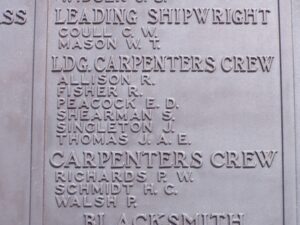
Charles Vincent Todman B.A., Lieutenant, Royal Air Force. Charles was born in Victoria Street, Laugharne on 12 January 1892, the son of William and Matilda Todman. The family later moved to Cricklewood, London, where Charles was educated at the University of London, gaining his B.A. before taking a job as a Teacher, employed by the London County Council. Charles enlisted into the army in April 1914, joining the 9th Battalion (Queen Victoria’s Rifles), London Regiment, which was attached to 13 Brigade, 5th Division. They landed at Le Havre on 5 November 1914, and fought through the Battles of Mons, Le Cateau, the Marne, the Aisne, La Bassée, Messines and the First Battle of Ypres. On 18 March 1915, Charles was promoted to Corporal, before being granted a Commission into the 10th Battalion (Hackney), London Regiment. He served with the 175th Trench Mortar Battery throughout the Battle of Passchendaele, before being evacuated to Hospital in England with severe Gas Wounds on 12 September 1917. Following an operation to remove his damaged tonsils, Charles left Hospital in Chelsea on 4 December 1917, and on 23 May 1918 was listed in the London Gazette as being appointed as a Lieutenant (Flying Officer) with the newly formed Royal Air Force, in Number 16 Squadron. Number 16 Squadron formed part of 41 Wing, based at Ochey in France. It mounted its first attack against a factory at Saarbrucken in Germany on 17 October 1917, and a week later carried out a night attack against the same target. The wing was later expanded with the inclusion of numbers 99 and 104 Squadrons. From June 1918, the wing gained greater involvement in bombing missions in Germany flying the RE-8 aeroplane from their new base at Camblain-l’Abbé. From there the Squadron were used in support of the First Army at their junction with the Second Army at Armentieres. Charles was acting as an Observer in an R.E.8, serial Number C2518 piloted by Lieutenant Percy West, on 3 August 1918, when they were attacked by three German Aircraft East of Vimy Ridge, whilst on Artillery Observation. After a brave fight, their attackers finally drove them down near Aubigny, and both men sadly died in the resulting crash, which was claimed as a victory by Leutnant Paul Billick of Jasta 52. Charles was buried at Aubigny Communal Cemetery, France, alongside his pilot, Percy West.
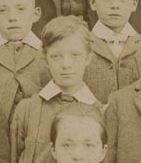
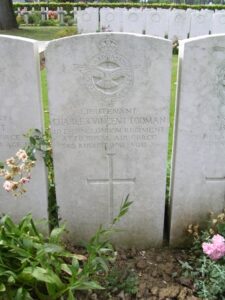
Gwilym Walters, Private, 201393, Welsh Regiment. Gwilym was the son of David and Mary Ann Walters, of Llanddarog. He enlisted at Pontyberem into the 1/4th Battalion, Welsh Regiment, which was formed during August 1914 in Carmarthen. The Battalion were then attached to 159 Brigade, 53rd (Welsh) Division, and in July 1915 sailed from Devonport for Egypt. On 9 August 1915 the Division had moved from Egypt, and landed on Gallipoli. They fought on Gallipoli until evacuation in December, 1915, after suffering terrible casualties, and moved to positions on the Suez Canal. In early 1917 the British launched an attack into Palestine, which was occupied by the Turks, and Gwilym was killed in action here, during the First Battle of Gaza, on 26 March 1917, aged 24. He is remembered on the Jerusalem Memorial, Israel. By the time of his death his parents were living in Clarence House, Laugharne. Gwilym is not commemorated at Laugharne, but is on the Pontyberem War Memorial.
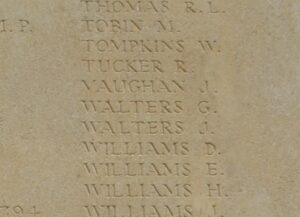
Frederick Charles Wardle, Private, WR/255844, Royal Engineers. Frederick was born in Hanley, Staffordshire in 1867. Just after the turn of the century, Frederick moved to Laugharne with his wife Margaret and on 2 May 1908 their daughter Margaret Florence was born at Primrose Cottage, Holloway Road. His wife died on 24 September 1912 and on 21 April 1915 Frederick married Edith Jackson. The couple had two sons, Frederick, born in 1915, and Martin, born in 1921. Frederick enlisted into the Royal Engineers following the outbreak of war and served with a Railway Company in France. Frederick was shot in the head just before the end of the war and was discharged from the army as medically unfit on 8 November 1918. Upon his return to Laugharne, the family moved into Craig-y-Don, The Cliff. Frederick’s health never recovered and he died on 15 August 1923, aged 56. He was buried in St. Martin’s Churchyard on 17 August 1923. Frederick is not commemorated by the CWGC and is not named on the Laugharne War Memorial.
Thomas Rees Waters, Lance Corporal, 44078, Welsh Regiment. Thomas was born in Laugharne on 4 October 1884, the son of John and Martha Waters, of Penrhiw, New Mill, Laugharne. Thomas enlisted into the army, and was posted to France during the summer of 1916 where he joined the 16th (Service) Battalion, Welsh Regiment, which was the Cardiff City Battalion, attached to 115 Brigade, 38th (Welsh) Division. The Division had been in France since December 1915, and had been posted to the Fleurbaix Sector for training. Thomas was drafted into France in April 1916, as part of the build up to the Battle of the Somme. It was in France that he joined ‘C’ Company of the 16th Welsh. Thomas was promoted to Lance Corporal in June 1916, and fought through the carnage of Mametz Wood, when the 16th Welsh was decimated during a futile attack on Mametz Wood on 7 July 1916. After the severe mauling that the 38th Welsh Division suffered at Mametz, they were withdrawn from front line service to rebuild and recover their immense losses. They then had the misfortune to be posted to the Ypres Salient, where they played a big part in the actions at Boesinghe and the Pilckem Ridge, during the Third Battle of Ypres, which is better known today as ‘Passchendaele’. After the Welsh Divisions successful capture of the Pilckem Ridge, the Division was withdrawn to rest areas, leaving the 15th and 16th Welsh behind to assist the 20th (Light) Division in an attack on Langemarck. Thomas was killed in action during a suicidal attempt to attack the German lines at Langemarck through a barrage on 27 August 1917. His body was never recovered, due to the terrible conditions of the Battlefield, and so he is commemorated on the walls of the massive Tyne Cot Memorial, Belgium. Thomas is not commemorated at Laugharne, but at Llanddowror.
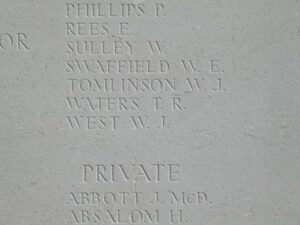
William Waters, Bombardier, 79715, Royal Garrison Artillery. Thomas was born in Laugharne around 1893, the son of John and Jane Waters of Pantyglas Farm, Broadway, Laugharne. He had an elder brother, Joseph, and younger siblings Mary Jane and Llewellyn Waters. William enlisted at the age of 22 years and 9 months along with his friend Herbert Roblin of Colston Farm, Laugharne, and was posted to the 216th Siege Battery, Royal Garrison Artillery, while Herbert was posted to the Royal Field Artillery. The 216th Siege Battery consisted of four 6″ howitzers, which together with their crews formed a small part of the 46th North Midland Division. The 46th Division had fought through some of the toughest campaigns of the Great War. They took a leading part in the opening of the Battle of the Somme in July 1916, and fought through the Battles of the Ancre, the German retreat to the Hindenburg Line in 1917, and through to the Battle for Hill 70. On 15 August 1917, the Battle for Hill 70 began, near Loos. Throughout the day, and the next, William’s gun crew were in action, firing their massive shells at the German lines, when a German shell crashed into their gun pit, killing William and the rest of the crew on 16 August 1917. William is buried at Maroc British Cemetery, Grenay, France, alongside his fallen comrades; William Holt and Henry Barber. Gunners William Wallbank, Alfred Steele, Albert Stanisford, John Richards, Simeon Johnson, David Dair, and Bombardier Albert Rowley, from the same Battery as William, all died within a few weeks of each other and are also buried at Maroc.
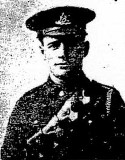
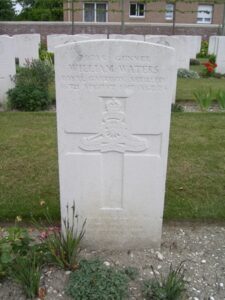
George Watts, Lance Corporal, 208, Australian Infantry. George was born in Laugharne on 4 February 1883, the son of John and Esther Watts, who lived at The Lakes, Laugharne. George also had two elder brothers Thomas and William Watts, who later lived at 25, Biggyn Road, Llanelli. George was another Laugharne man with a taste for adventure. On 31 May 1902, George enlisted at Devonport into the Royal Navy, signing up for 12 years. He served for over five years in the Royal Navy on active service, and for six years on the reserve. In 1914, George found himself in Australia, working as a miner, and on 28 September 1914, he enlisted in Townsville, into the 15th Battalion, Australian Imperial Force, which was part of 4 Brigade, 4th Australian Division. George embarked at Melbourne on 22 December 1914 aboard the Australian Troopship Ceramic, bound for Egypt. On 25 April 1915 the Australians landed on the shores of Anzac Cove, Gallipoli, and were thrown into desperate fighting. From May to August, the 15th battalion was heavily involved in establishing and defending the ANZAC front line. On 14 July 1915 George was admitted into the 4th Field Ambulance, and sent to the Greek Island of Mudros, with a boil on his neck. He returned to Gallipoli, but was again admitted to the 4th Field Ambulance at Anzac beach on Gallipoli on 11 August 1915. George returned to his Battalion the next day and found himself caught up in one of the final stages of the Gallipoli campaign, the Battle for Hill 60. A detachment from ‘A’ Company of the 15th Battalion was sent to reinforce the 13th Battalions unsuccessful attempt to take the position. It was during this futile struggle that George was wounded, and taken to the 16th Casualty Clearing Station, on 27 August 1915, to be treated for a gunshot wound to his left arm. George was ferried aboard the hospital ship Huntsgreen, where he died of his wounds on 30 August 1915. The chief officer aboard HS Huntsgreen buried George at sea that day. George is commemorated alongside 4,931 comrades on the Lone Pine Memorial, Gallipoli.
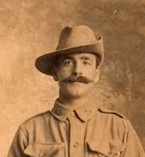
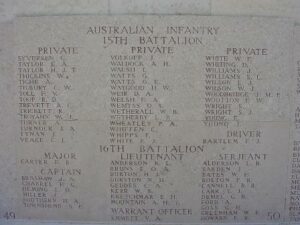
William Whitehead, Private, 2097, Welsh Guards. William was from Kilscorran, Wexford, Ireland, but prior to the war had moved to Laugharne, where he was in service at Milton Bank. He enlisted into the Welsh Guards at Carmarthen and was posted to France, possibly in the summer of 1916, to join the 1st Battalion, Welsh Guards, which was attached to the Guards Division. During the spring of 1917 the Guards Division followed up the German withdrawal to the Hindenburg Line. William was wounded during this time, and died of his wounds in hospital at Rouen on 13 April 1917. He is buried in St. Sever Cemetery Extension, Rouen, France. William is not commemorated at Laugharne.
John Williams, Private, 228269, Monmouthshire Regiment. John was the son of Thomas and Martha Jane Williams, of 19, Market Street, Haverfordwest. His father Thomas was from Laugharne, and John regularly visited family in the Township. He was a fish and chip merchant prior to the war, and enlisted at Haverfordwest into the Monmouthshire Regiment in December 1915. John was posted to France on 30 May 1917, and within days was transferred to the 11th Battalion, South Wales Borderers, which was attached to 115 Brigade, 38th (Welsh) Division. He joined the battalion at Boesinghe, where it had held the line since being withdrawn from the Somme in 1916. Here they fought at the Battle of Pilckem Ridge, which is where John was killed on 31 July 1917. He was 22 years old, and is buried at Artillery Wood Cemetery, Belgium. John is not commemorated at Laugharne.
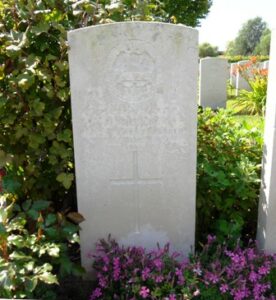
Eric Western Wilson, Second Lieutenant, West Yorkshire Regiment. Eric was born on 12 July 1893 at Thornton-le-Moor, Yorkshire, the only son of John Western Wilson and Caroline Mary Wilson (nee David), later of The Corse, Laugharne. Eric was a nephew of Engineer Lieutenant Commander Thomas Morgan David. Eric was educated at Carmarthen Grammar School, at Kelly College, Tavistock, and at Leeds University, before graduating from the University Officer Training Corps, and was commissioned into the Special Reserve, the Prince of Wales Own West Yorkshire Regiment in July 1913. He had in the meantime qualified as an electrical engineer, gaining a Bachelor of Science drgree. He joined the 1st Battalion, West Yorkshire Regiment on the outbreak of war, which was stationed at Lichfield. They were sent to France with the BEF, landing at St. Nazaire on 10 September 1914, as part of 18 Brigade, 6th Division. The German Army had been hard hit by the BEF in early September, and by 11 September 1914 it was clear to the British that the Germans had retreated behind the River Aisne. On 15 September, Marshal Joffre ordered the French and British armies to attack the withdrawing Germans. This action became known as the Battle of the Aisne. The main attack was carried out by the British, against the Chemin-des-Dames ridge in the direction of Laon. On 20 September 1914, Eric was killed in action, around 60 kilometres east of Paris, on the river Marne, while leading his platoon to recapture a trench near Troyon that had been taken by the enemy earlier in the day. He has no known grave, and is remembered on the La Ferté-Sous-Jouarre Memorial, France. He was just 21 years old, and the first Laugharne man to be killed in the Great War.
